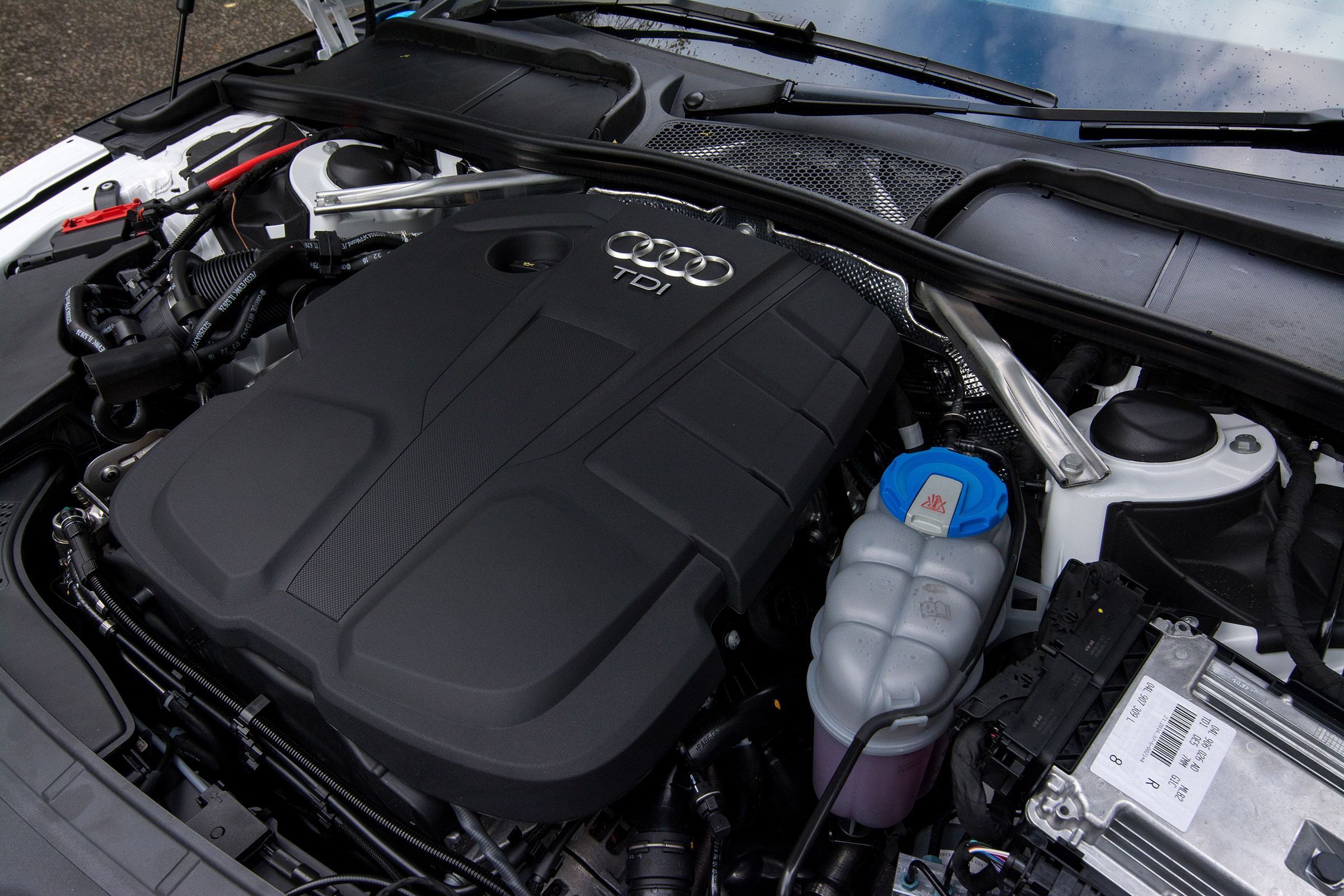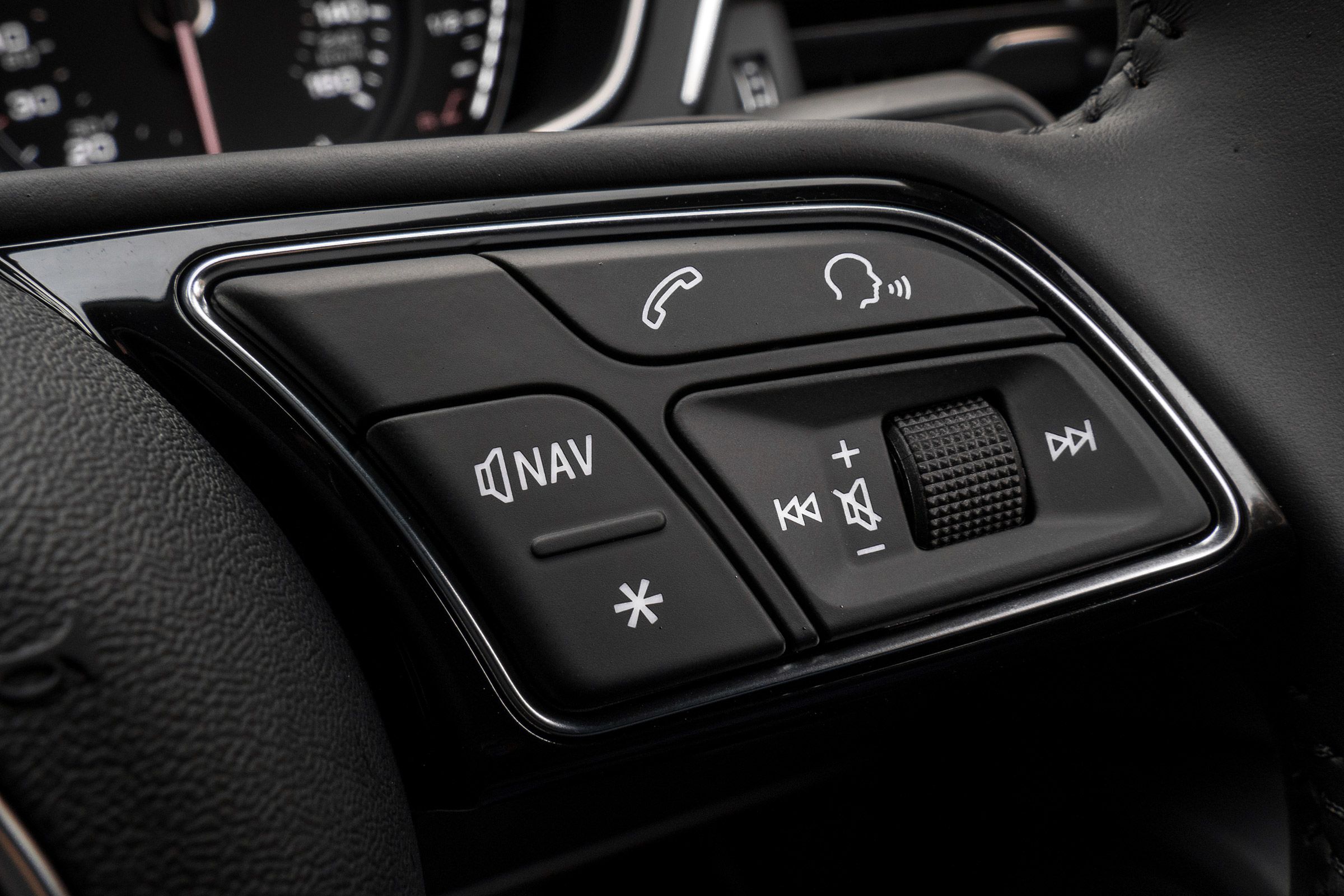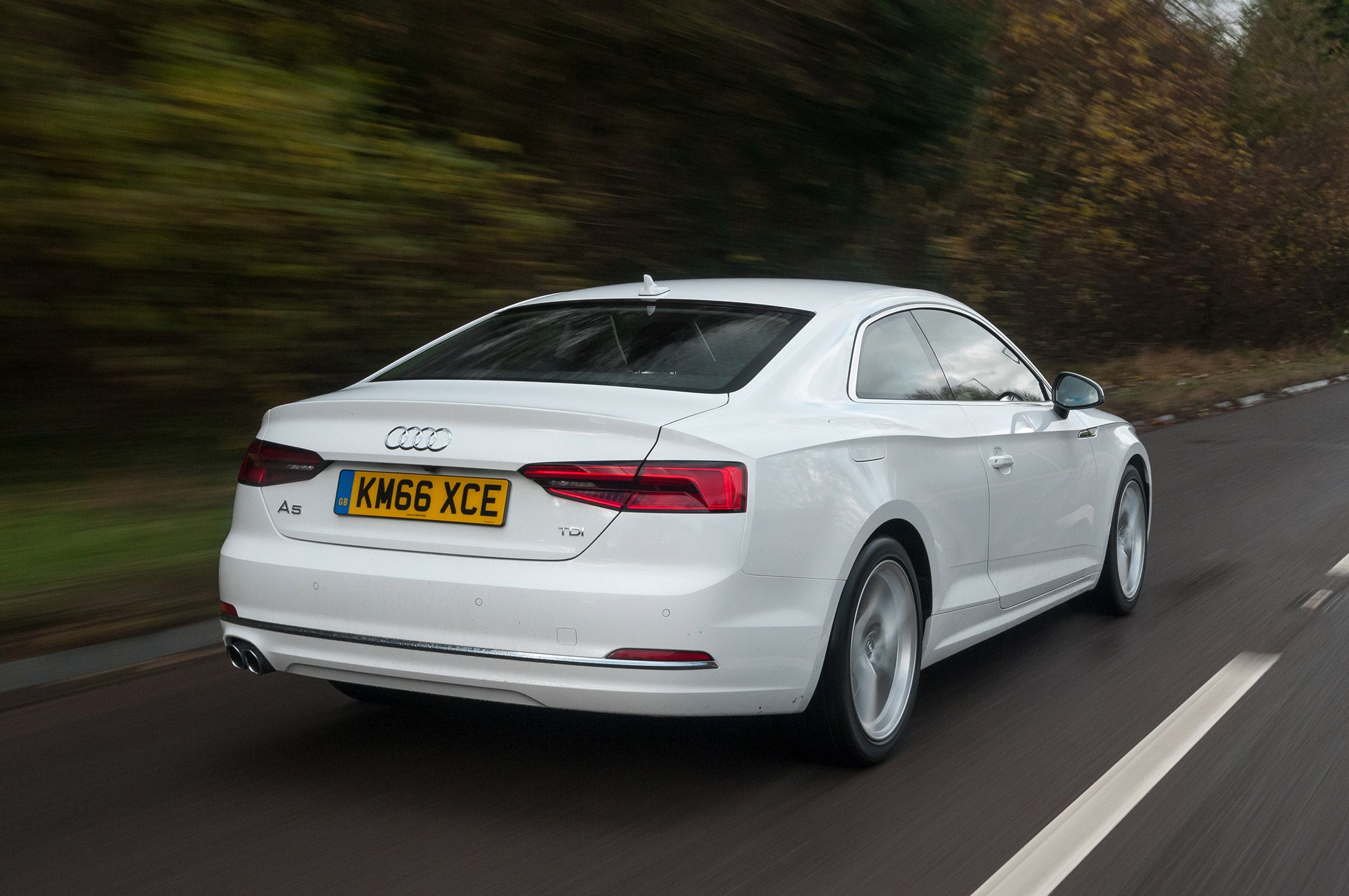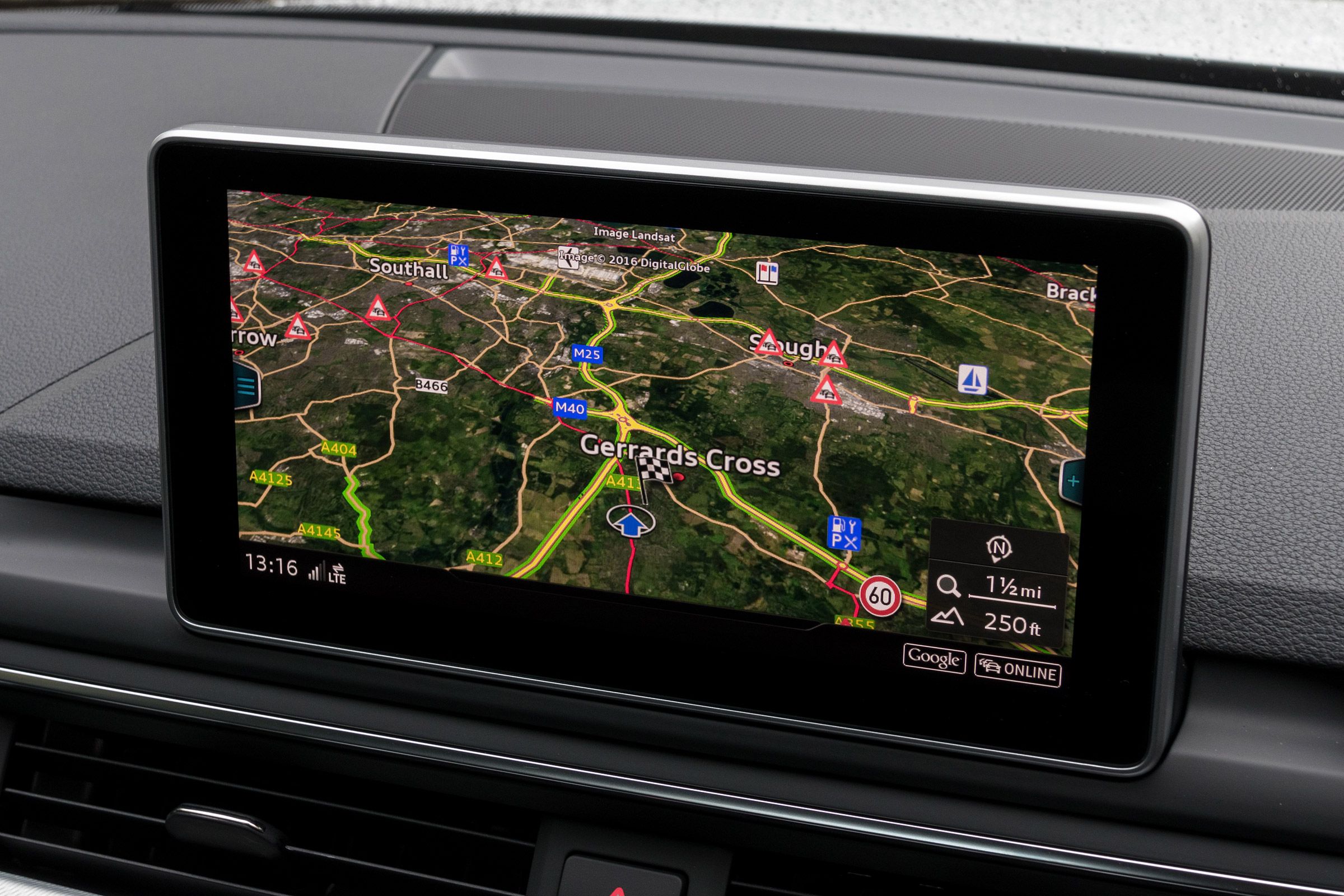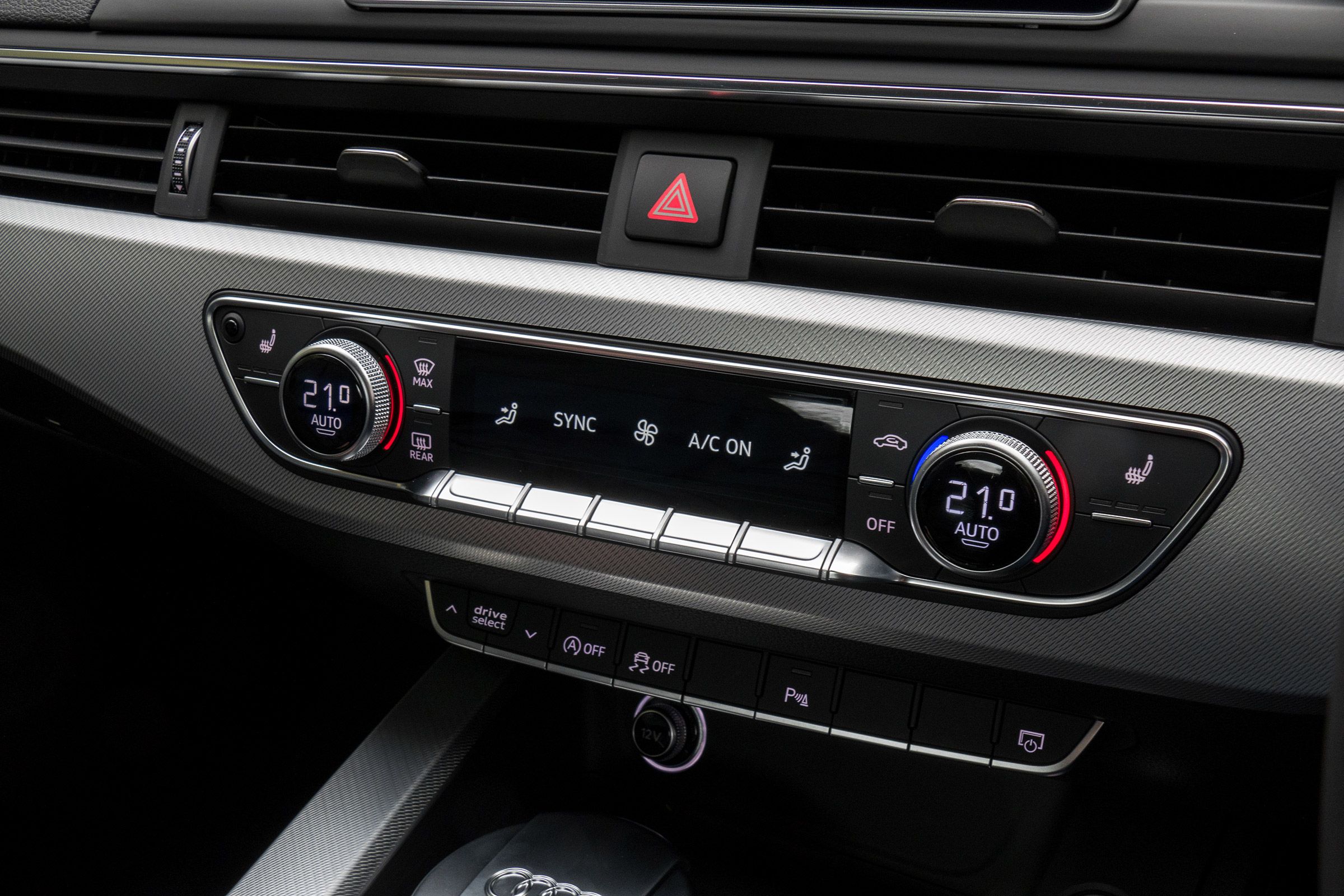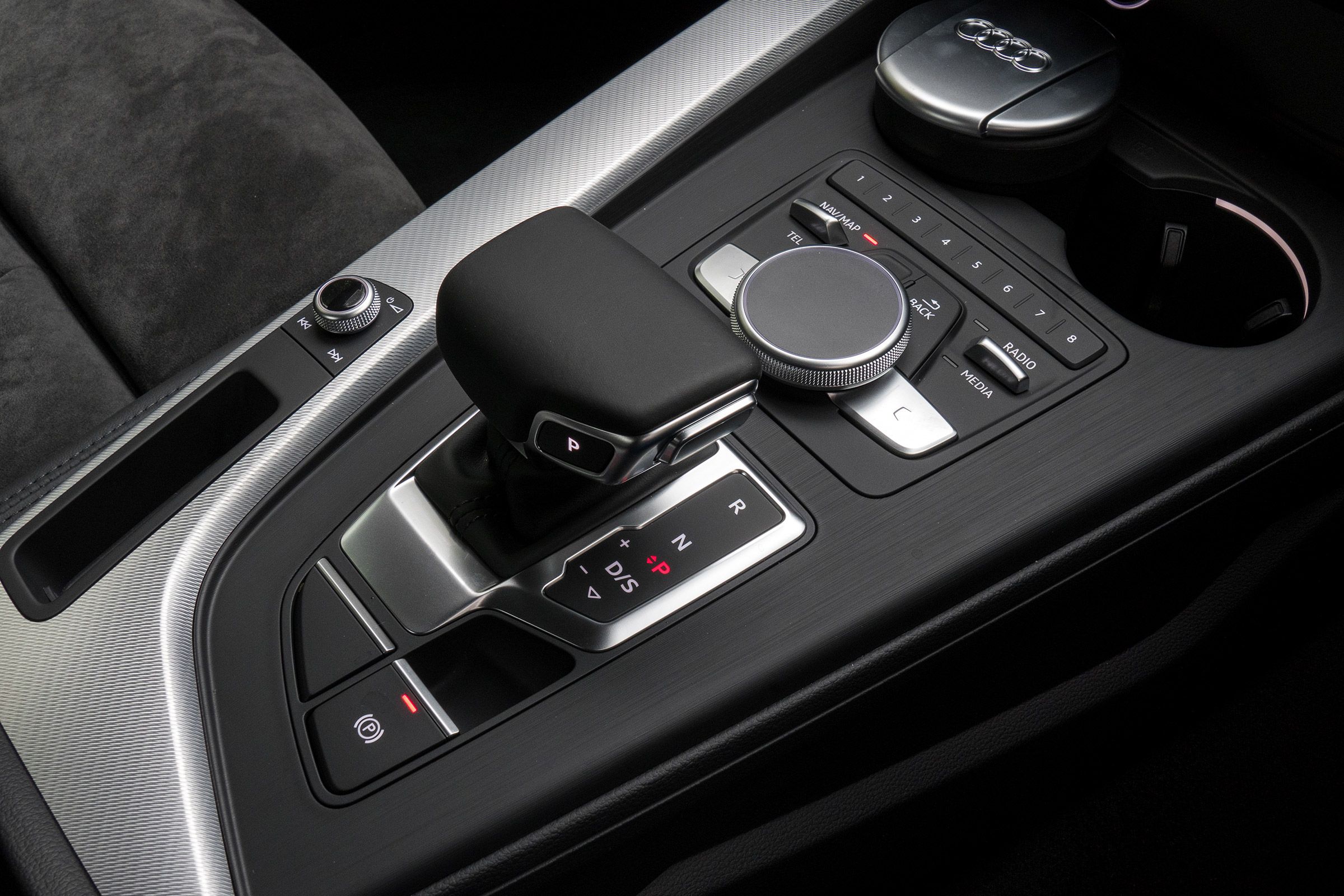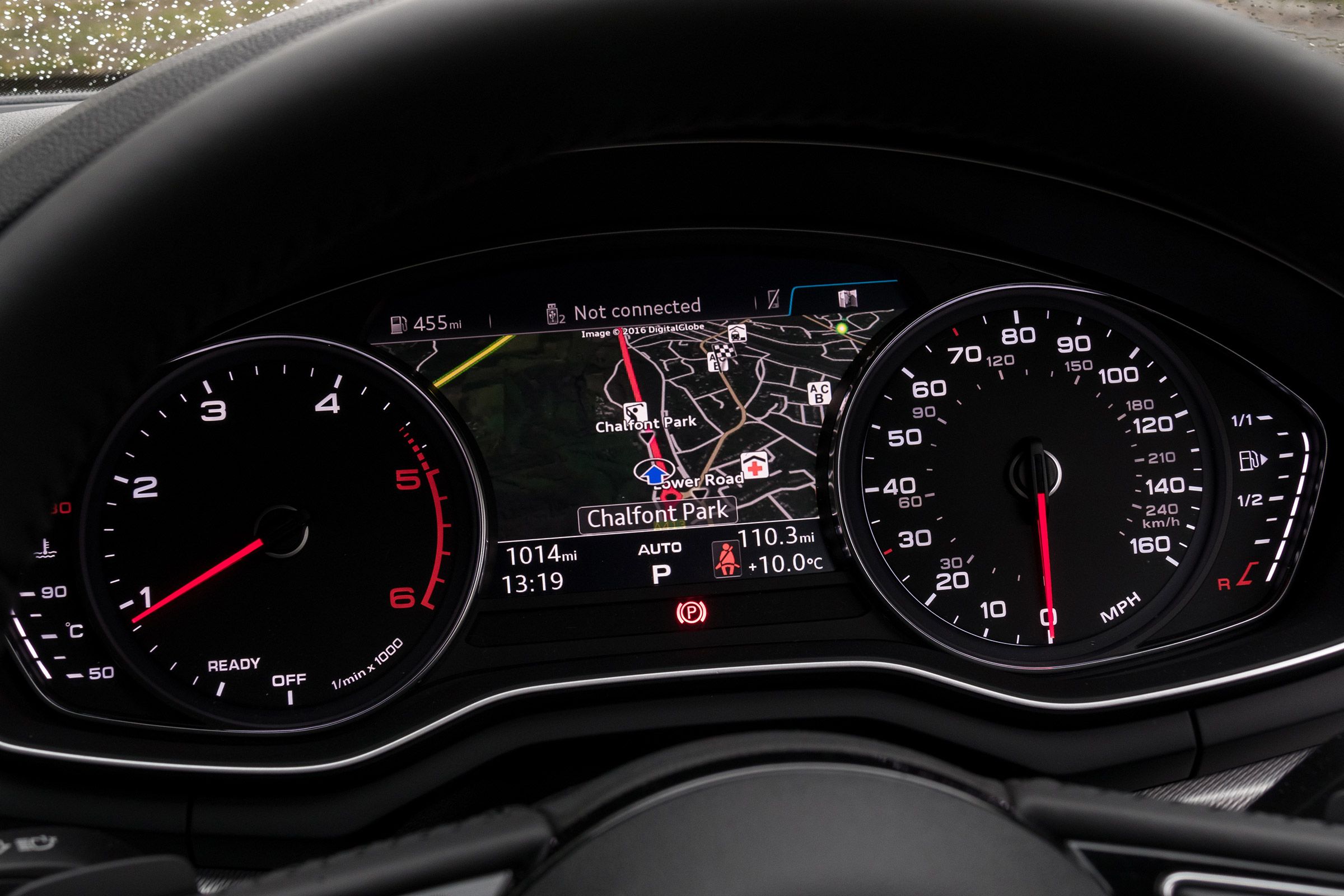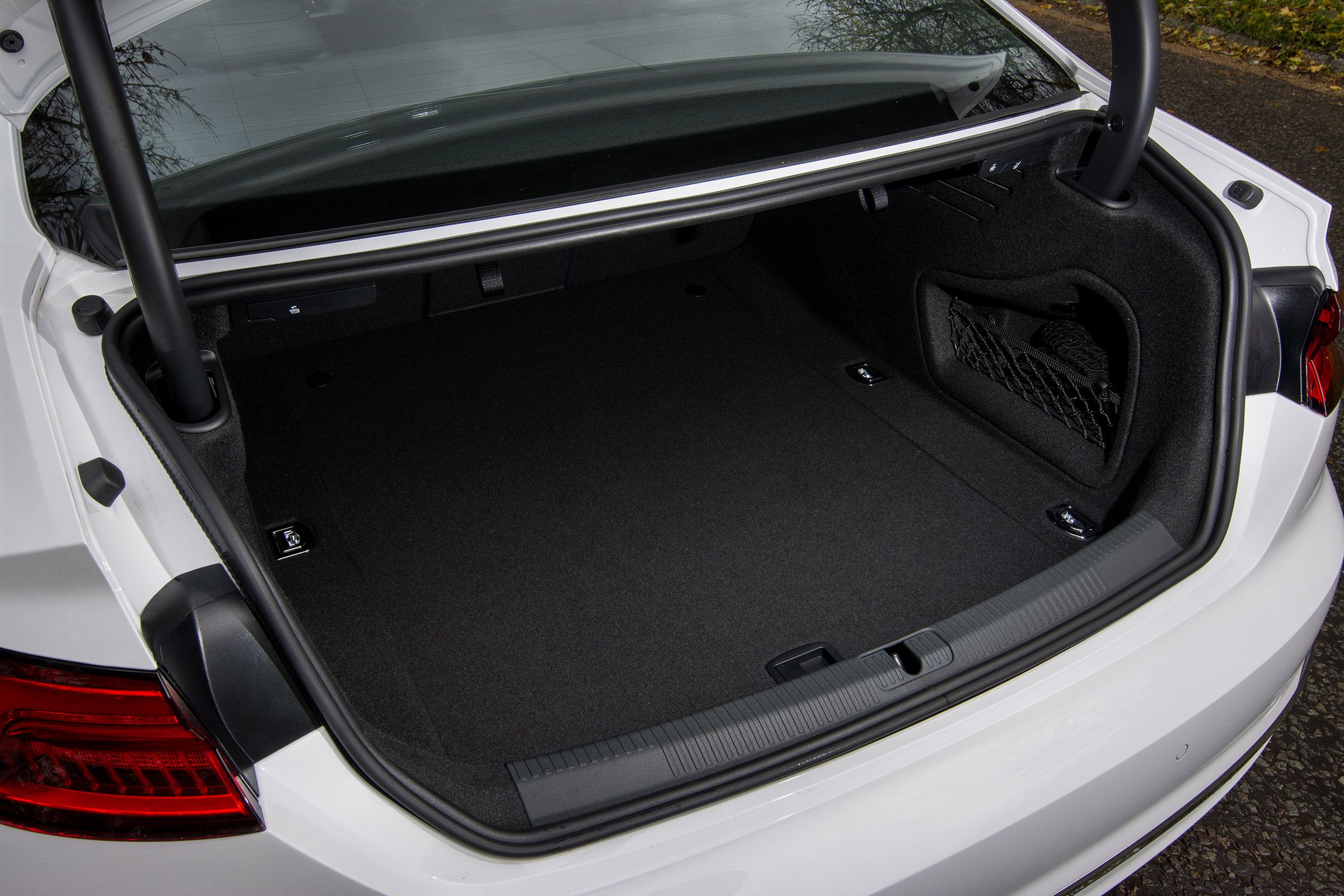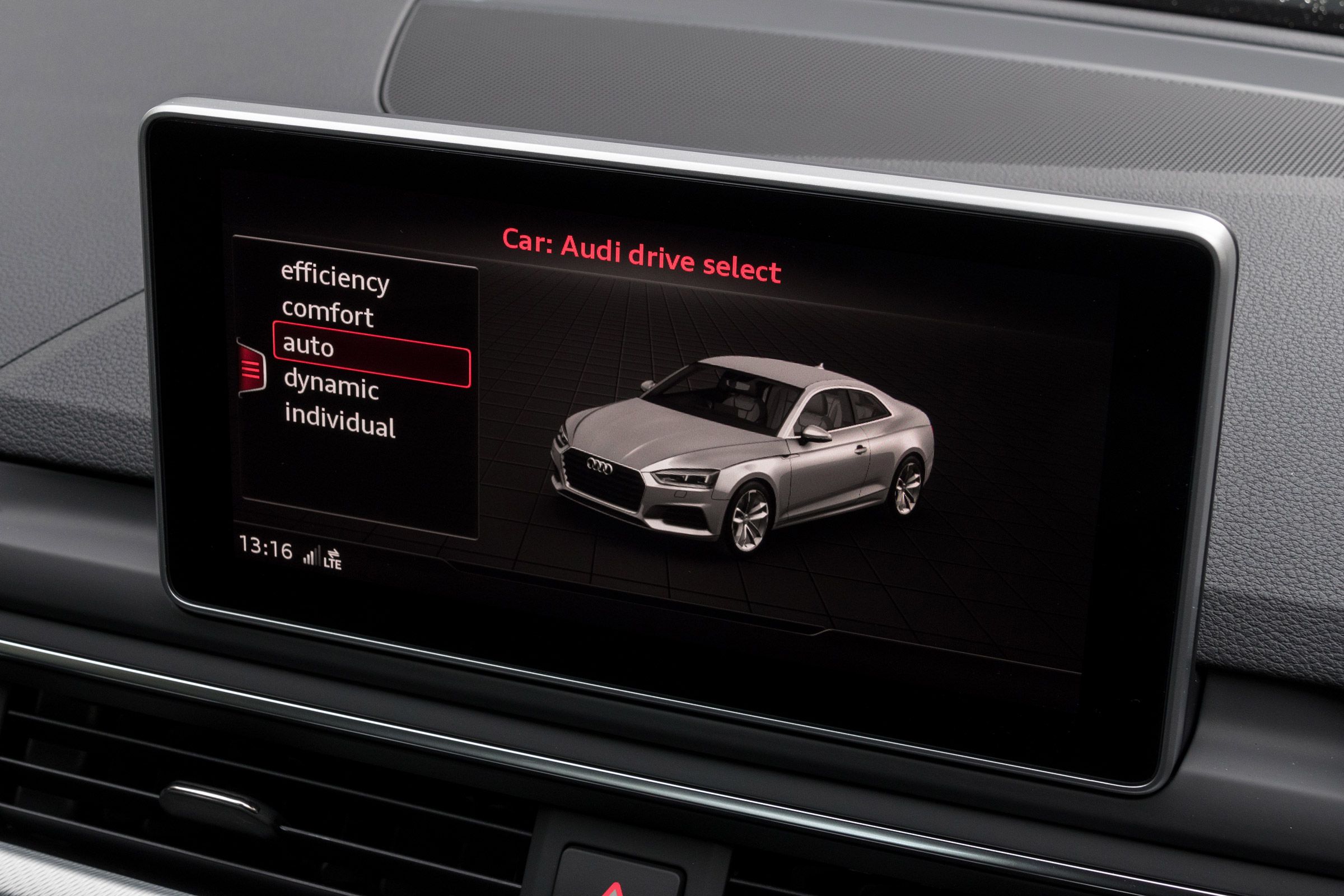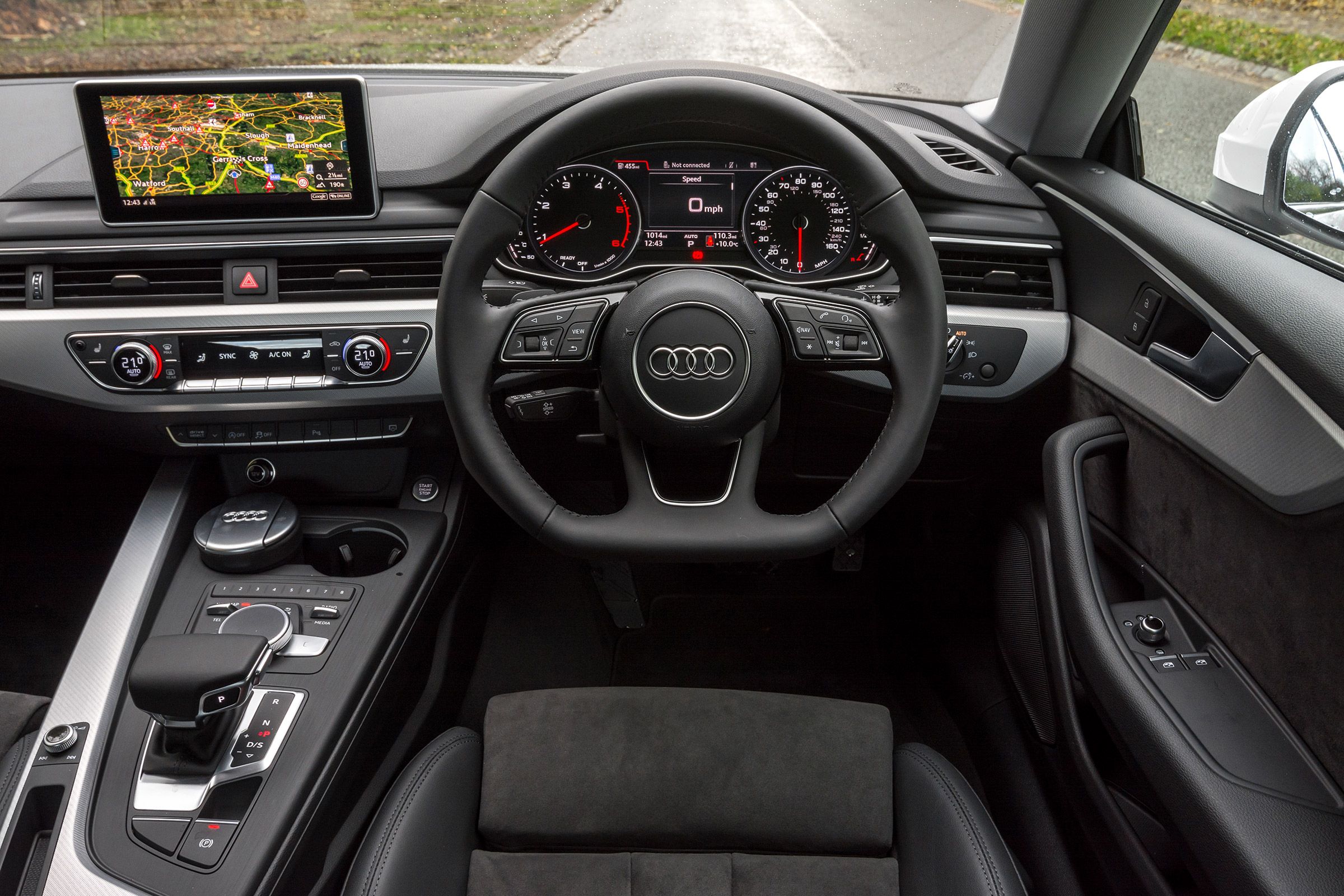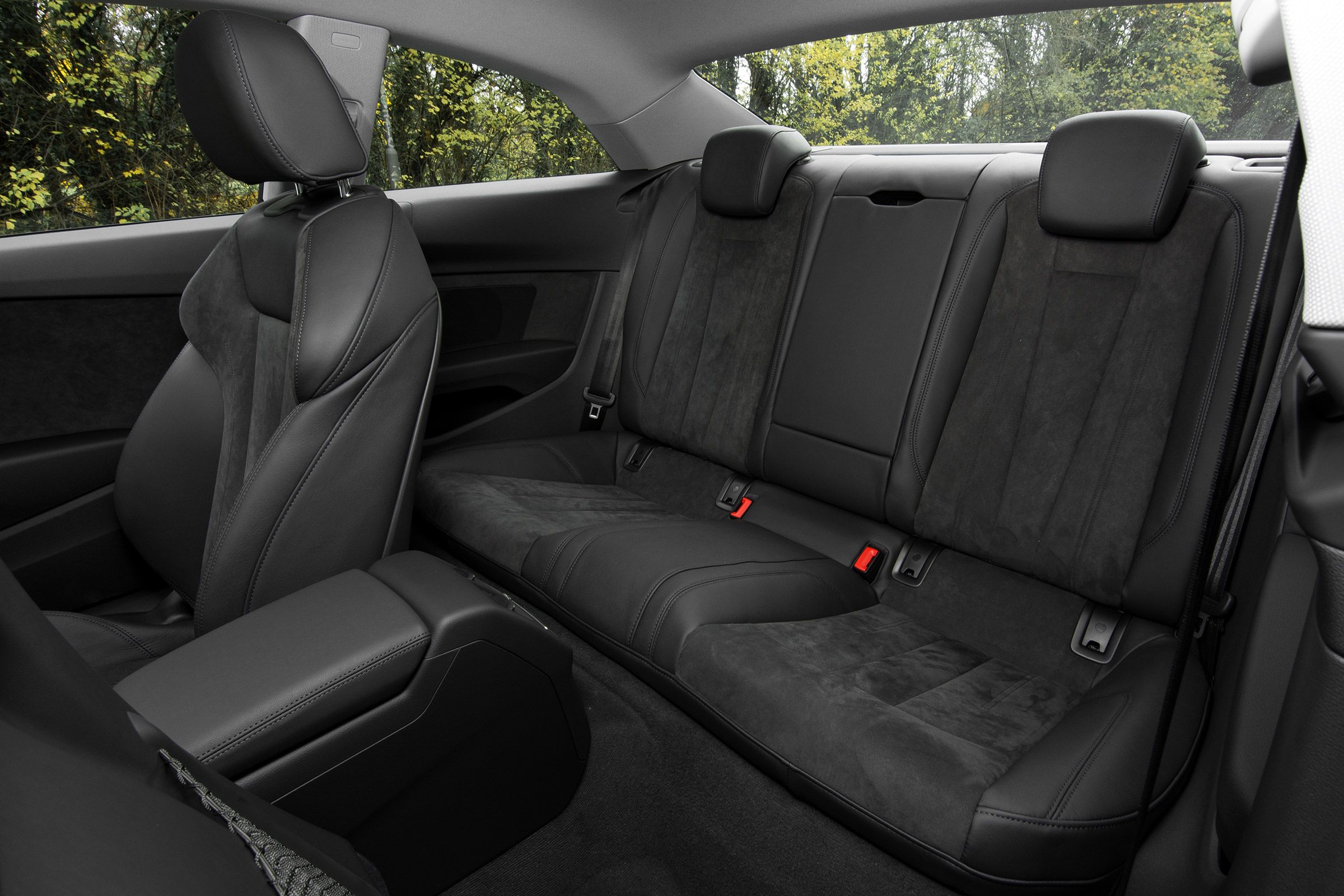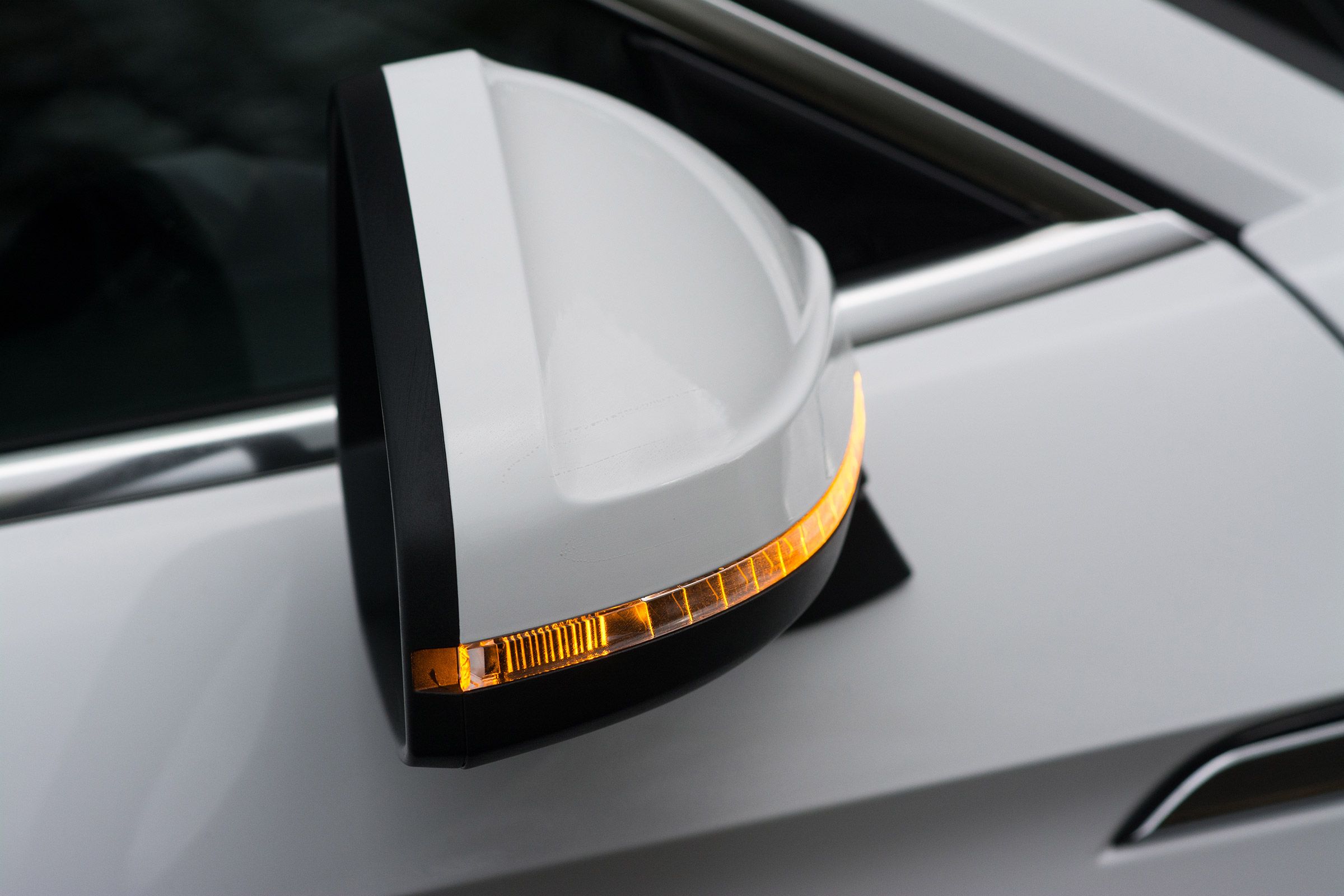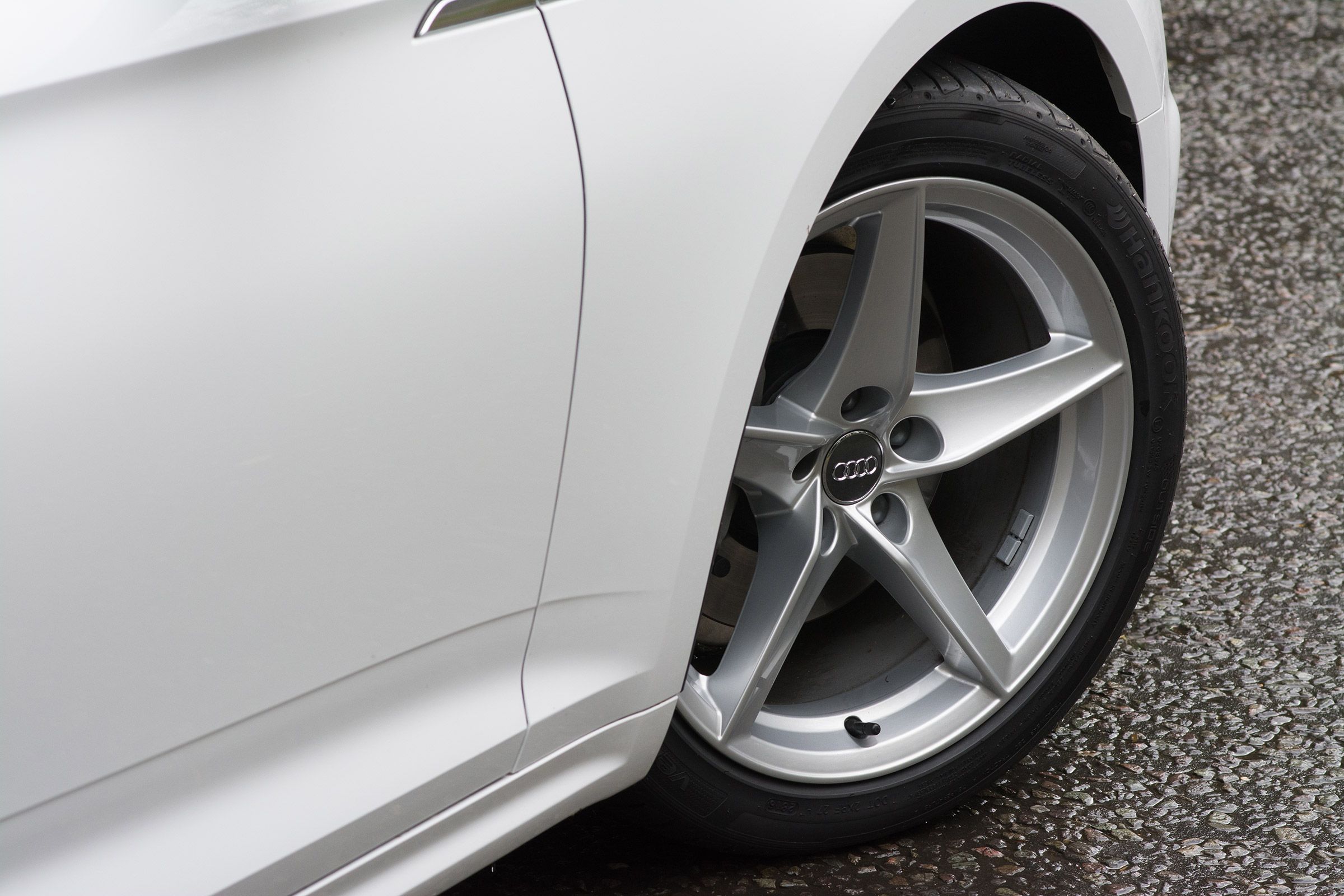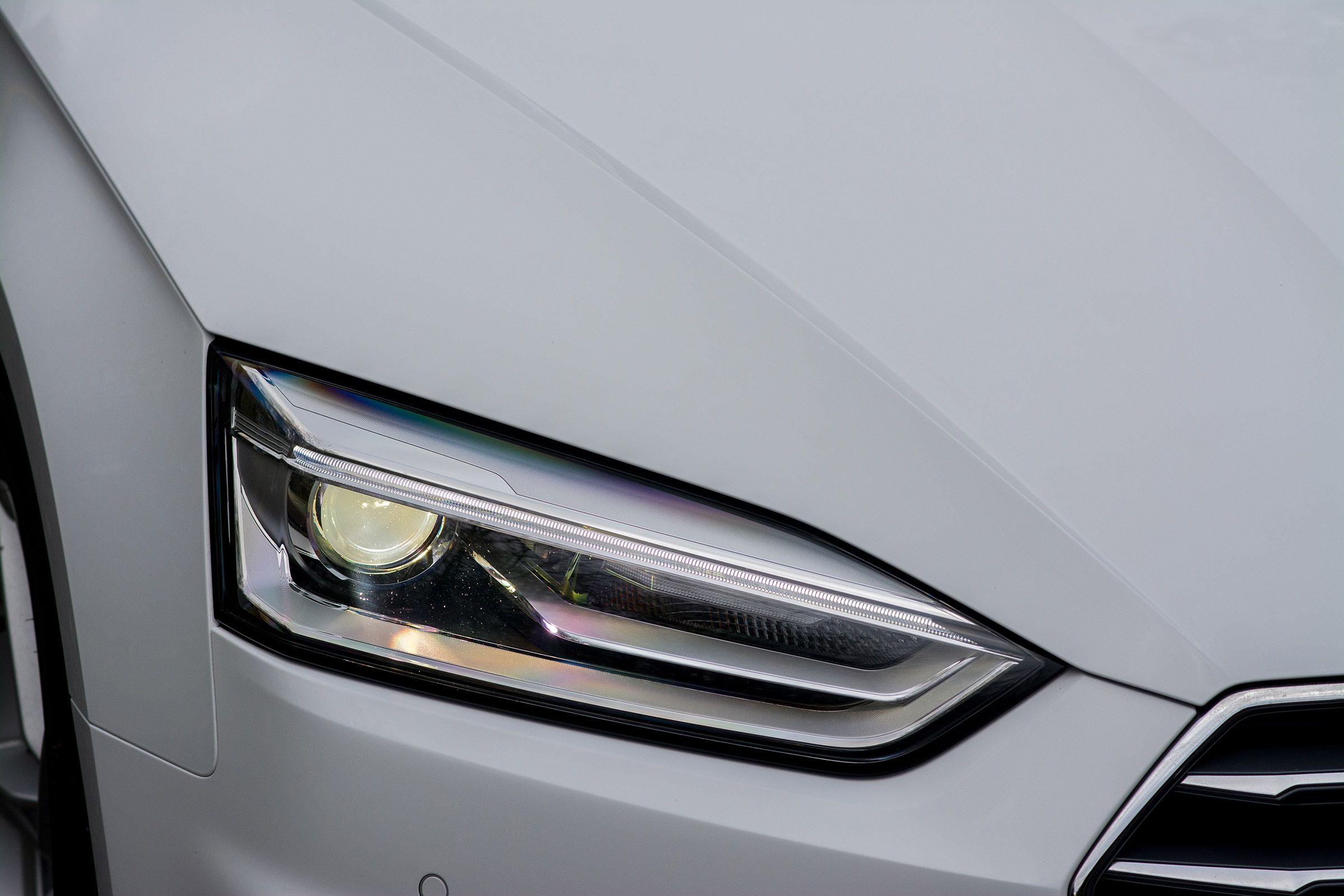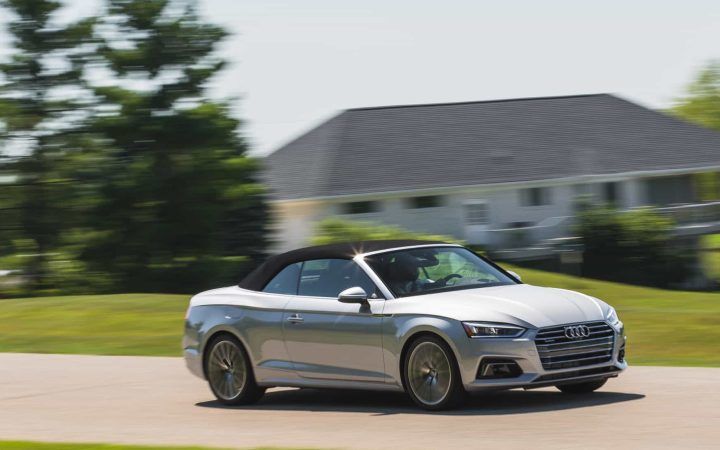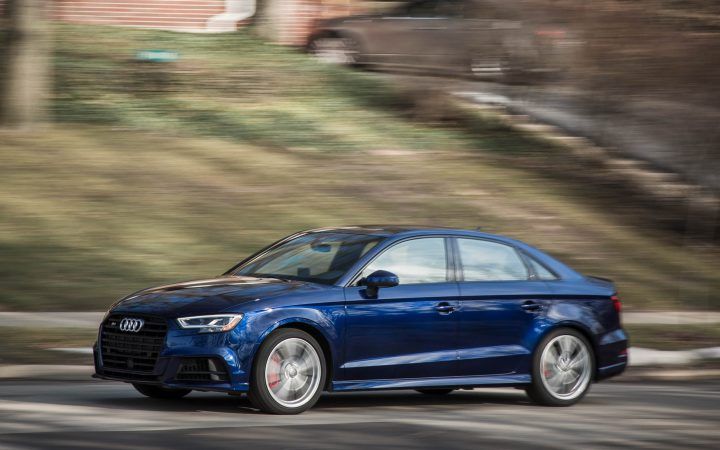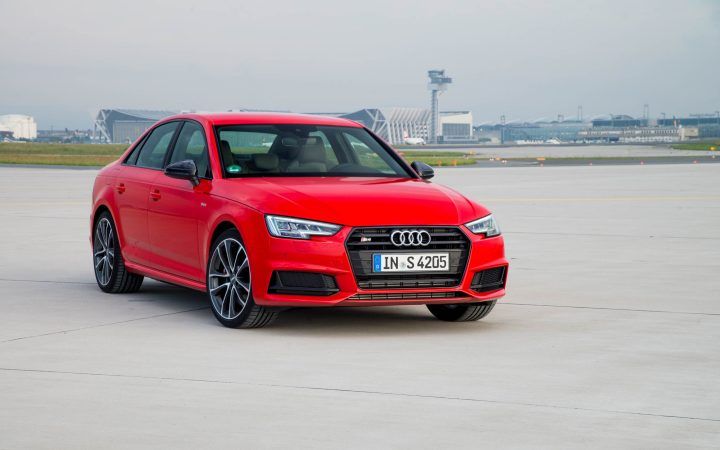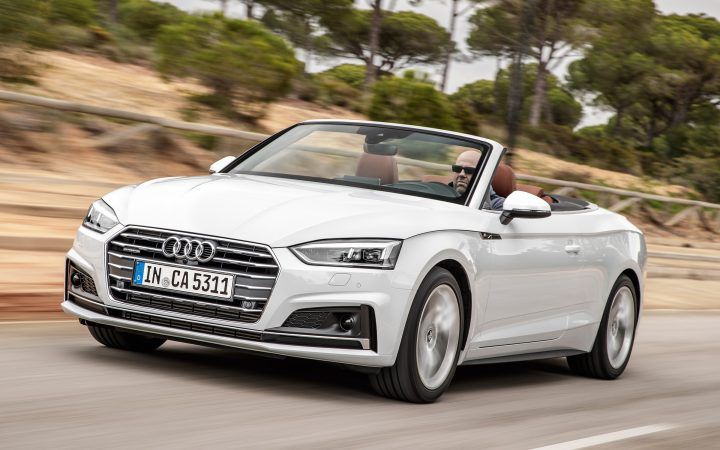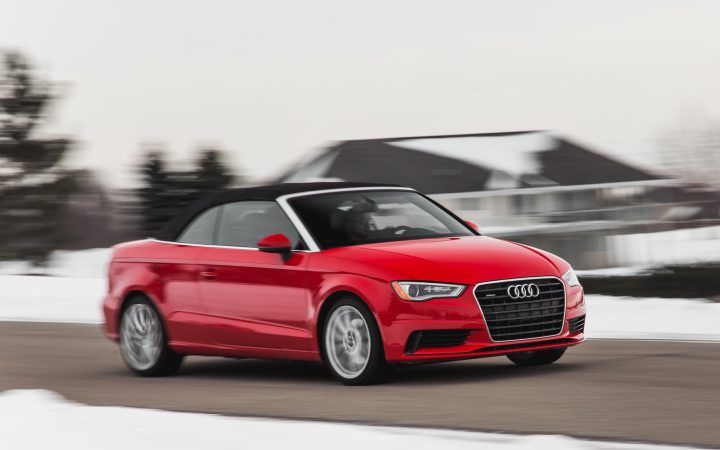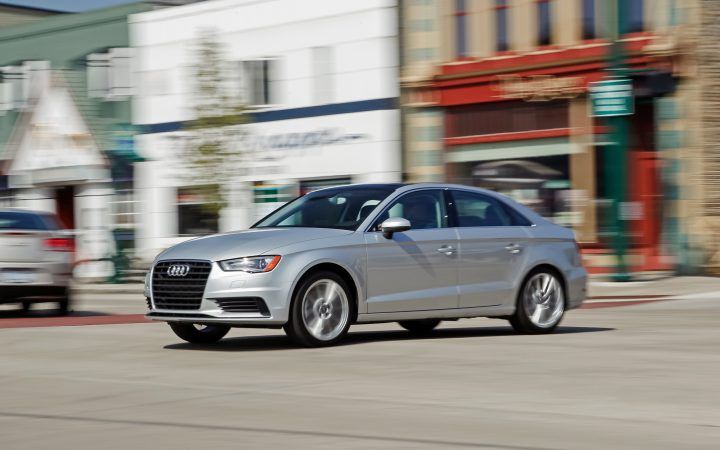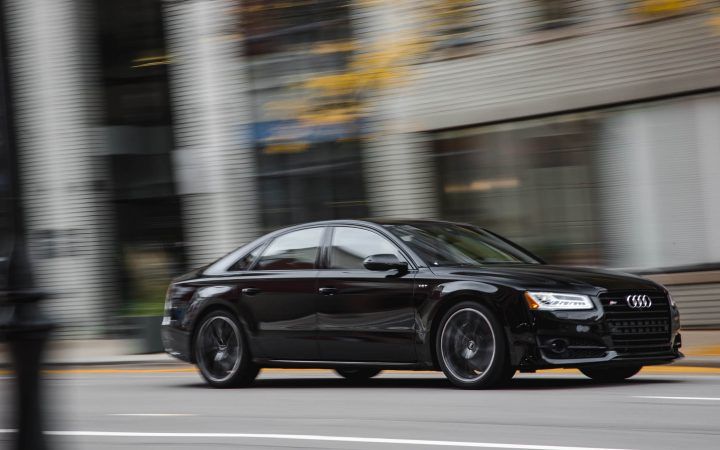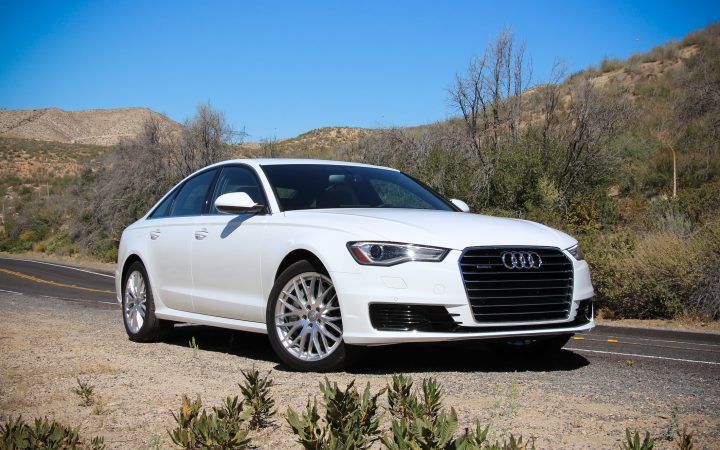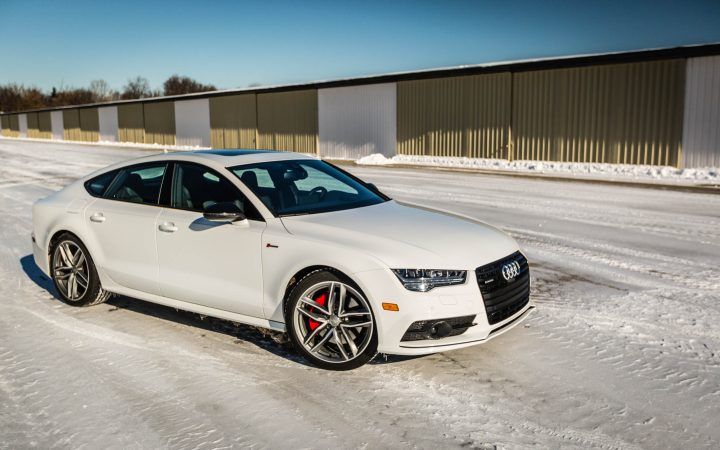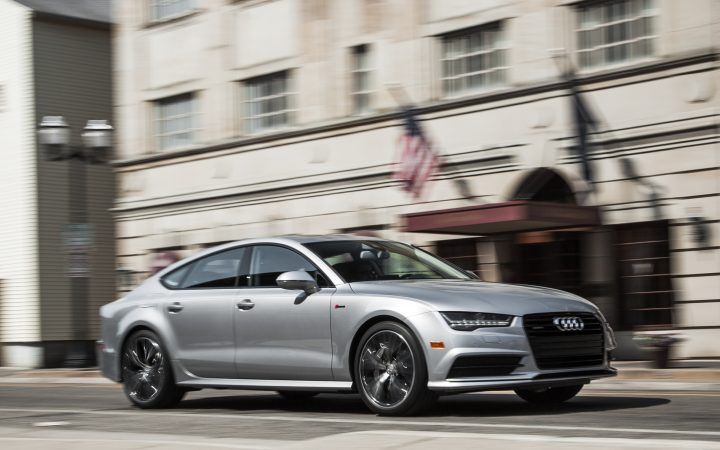The year 2017 marked a complete redesign of the Audi A5 Coupé, which now offers 252 horsepower, as well as a manual transmission to create an immensely dynamic driving experience. Its compellingly athletic, elegant design is accentuated by advances in aerodynamics, a newly engineered chassis, powerful engines and state-of-the-art infotainment and driver assistance systems. In 2007, Audi shook up the mid-size class with its introduction of the A5, with a second generaton now catching attention across the globe nine years later.
For many years, Audi designers have been attempting to answer an important query: How could they manufacture a modern, sophisticated, and sharpened look while still preserving the sporty and refined character of the A5 Coupé? Their resolution is remarkable. The three-dimensional, wave-shaped shoulder line previously seen in the model is now more distinguishable, with lumps over the wheel arches that emphasize the quattro all-wheel drive.
The proportions of the Audi A5 Coupé are entirely balanced, featuring a lengthy engine hood, an expanded wheelbase, and brief overhangs, all of which bring out the car's sportiness. The Singleframe grille is flatter and broader than its predecessor, accompanied by LED rear lights and optionally LED or Matrix LED headlights, showcasing high-end technology even in the evening.
The Audi A5 two-door coupé possesses dynamic contours and surfaces which reflect its athleticism, while the pronounced wheel arches emphasize its quattro DNA. A three-dimensional chrome trim element further delineates the connection between the front wheel arch and the doors, and the exterior mirrors are mounted atop the shoulders of the doors for a sleek appearance. The roof of the A5 resembles a flat dome, complemented by a matte aluminum silver trim strip which frames it.
The front of the A5 presents a flatter and wider three-dimensional Singleframe grille than its predecessor. It may come in a subtle matte black, a light and sporty matte twilight grey with matte aluminum silver horizontal slats in the A5 Sport trim line, or a dark titanium black with chrome horizontal slats in the A5 Design trim line. The commendable edges of the side air intakes are visible and can be further enhanced with an optional S Line exterior package, which includes honeycomb grilles and a horizontal trim strip in matte aluminum silver.
The sleekly sculpted headlights of the new Audi A5 Coupé are slightly elevated above the top edge of the Singleframe grille. Optional LED and Audi Matrix LED headlights boast all lighting functions in LED technology. The Matrix LED headlights have a four-eyed light signature, with the low and high beam combining to create a double eye effect. Standard xenon headlights come with daytime running lights on the upper edge of the housing, which also serve as the turn signal. The Matrix LED headlights have 18 LEDs that are switched on and off or dimmed in 64 steps as needed, with cornering light activated before the steering wheel is turned and the dynamic turn signals created by a row of sequentially activated light-emitting diodes.
The rear of the new Audi A5 Coupé is characterized by horizontal lines and a distinctive spoiler lip on the luggage compartment lid. Separate reflectors in the lower section of the rear apron, painted in the body color, emphasize the width of the two-door coupé. The exhaust system is either single or dual-branch, with a twin exhaust tailpipe on the left (TDI) or two separate tailpipes (TFSI) in the sport trim lines, finished with chrome tips.
The slender, three-dimensional tail lamps are incorporated into LED technology as a standard feature. The contoured design of their geometry is complemented by the LED lighting effect, while the outermost vertical edge of the rear end is emphasized. Right underneath the lamps is the tasteful brake light and above is the dynamic indicator with LED headlamps. Light guide technology is used for the third brake light, an elegant and subtle thread at the upper edge of the rear window, spanning the whole width.
The Audi A5 Coupé provides purchasers with multiple modular equipment lines, which contain external features. In addition to the basic model, the Sport and Design lines are also accessible. The S line Sport bundle and the Audi Design Selection outer cover options enhance the interior. The S line exterior package can be combined with any of the trim lines or styling kits to generate a personalized and frenetic look, comprising a dim gray radiator grille with matt aluminum silver fin patterns, athletic front and rear bumper, monochrome titanium black air inlesh grilles with a beehive layout, an energizing horizontally-laid matt aluminum silver trim strip that crosses the full width of the front end, body-painted sill trims along with black-textured side sill strips, matte twilight grey diffuser equipped with a built-in black-textured honeycomb grille, luminous door sill trims featuring an S rhombus icon, and a chrome trim element on top of the front flanges with an S line emblem.
The latest version of the Audi A5 Coupé comes in 15 different coatings, including both solid (such as brilliant black and ibis white) and metallic (like Argus brown, cuvée silver, Daytona gray, floret silver, glacier white, Gotland green, Manhattan gray, matador red, moonlight blue, monsoon gray, mythos black, scuba blue, and tango red). The S line Sport Package and S line exterior Package come equipped with the Daytona gray tint.
This latest iteration of the Audi A5 Coupé has increased in length by 47 millimeters, now measuring 4,673 millimeters in overall length. The width is 1,846 millimeters, with a reduction of 8 millimeters, and the height 1,371 millimeters, with a reduction of 1 millimeter. These dimensions make it the most dynamic car in the premium segment. The wheelbase has furthermore been increased by 13 millimeters, to a total of 2,764 millimeters.
The new Audi A5 Coupé will be released in Germany with two TFSI and three TDI engines, providing an output of between 140 kW and 210 kW, respectively. Fuel consumption has been decreased by up to 22 percent compared to its predecessor, while power output has increased by as much as 17 percent. All engines comply with the Euro 6 emission standards. The standard tank capacity is 12 liters, while an optional tank of 24 liters is also available. Furthermore, the updated start–stop system comes as standard, designed to further reduce fuel consumption. With S tronic transmission, the engine can be deactivated at less than 7 km/h, and at less than 3 km/h with tiptronic transmission.
The brand-new Audi S5 Coupé distinguishes itself from its rivals. Featuring an expansive 3.0 TFSI power plant with a displacement of 2,995 cc, it produces a commanding output of 260 kW (354 hp), more than 15 kW (21 hp) than what the previous model did.
For the Audi A5 Coupé, two versions of the 1,984cc, 2.0 TFSI engine are offered. It comes with an integrated exhaust manifold in the cylinder head, a rotatable core module for thermal regulating, the Audi valvelift system (AVS) for exhaust valves, an electronic waste gate for the turbocharger and dual injection – indirect intake injection and FSI direct injection.
The best 2.0 TFSI iteration supplies 185 kW (252 hp) and a maximum torque of 370 Nm (272.9 lb-ft) between 1,600 and 4,500 rpm. When matched with quattro all-wheel drive, the Audi A5 Coupé can accelerate from 0 to 100 km/h (62.1 mph) in 5.8 seconds and reach an electronically restricted top speed of 250 km/h (155.3 mph). It sips fuel moderately, as it delivers an astonishing figure of 5.9 liters per 100 kilometers (39.9 US mpg), equal to 136 grams of CO2 per kilometer (218.9 g/mi).
The moderately powered 2.0 TFSI variant produces 140 kW (190 hp) and 320 Nm (236.0 lb-ft) of torque from 1,450 to 4,200 rpm. It zips from 0 to 100 km/h (62.1 mph) in 7.3 seconds, achieving a top speed of 240 km/h (149.1 mph) with the S tronic transmission. Despite itspowerful performance, it is still able to be fuel efficient at 5.1 liters per 100 kilometers (46.1 US mpg) with 117 grams of CO2 per kilometer (188.3 g/mi).
Audi has struck a perfect balance between power and efficiency with the 2.0 TFSI engine in their hit model, the Audi A5 Coupé. This powerful unit has a large displacement which is a prerequisite for its remarkable performance. Owners of the Audi A5 Coupé can drive either leisurely or more aggressively when they please.
The latest combustion process, which features a shorter compression stroke and a longer power stroke, as well as a compression ratio of 11.7:1, has been specifically engineered for circumstances in which the engine is not running at full capacity. In such low power scenarios, the intake valves will close earlier than what is normally expected, which results in reduced throttling losses during the intake due to the seen elevations in the pressure within the intake manifold. To ensure that an adequate level of swirl is sustained despite the limitations placed on the inlet's active timeframe, the combustion chambers, piston recesses, inlet ducts and turbochargers of the new 2.0 TFSI were designed to interact well with this new combustion technique. When the engine is running at higher power levels, the Audi valvelift system will delay the opening of the intake valves, thus allowing for improved power and torque production via the increased fill level. The injection pressure of this system has also been raised to 250 bar.
The 1,968 cc, four-cylinder TDI installed in the newest edition of the Audi A5 Coupé is capable of releasing 140 kW (190 HP) at its peak and can generate a torque of 400 Nm (295.0 lb-ft) within the range of 1,750 to 3,000 rpm. This powerful four-cylinder diesel engine provides superior performance and remarkable efficiency. When matched with the seven-speed S tronic and quattro all-wheel drive, it can accelerate from 0 to 100 km/h (62.1 mph) in 7.2 seconds and reach the maximum speed of 235 km/h (146.0 mph). When this engine is coupled with the seven-speed S tronic and front-wheel drive, it will consume only 4.4 liters of fuel per 100 kilometers (53.5 US mpg) according to the NEDC standard, with a CO2 equivalent of 114 grams per kilometer (183.5 g/mi).
The 2.0 TDI has a range of advanced technical features, such as separate coolant loops, two balance shafts adjoined to the crankcase, a cylinder pressure sensor and reduced internal friction, along with a common rail injection system, which operates at a maximum fuel pressure of 2,000 bar. Low and high-pressure exhaust gas recirculation coupled with effective exhaust gas treatment, including a Selective Catalytic Reduction system (SCR), allows for the operation of the engine at reduced emission levels.
The Audi vehicle lineup offers a 2.0 TDI model in an "ultra" version, which can be identified by a badge on the rear. This version has been designed to be the most fuel-efficient in its respective line through alterations to the transmission ratio and body, and the addition of low rolling-resistance tires. The current Audi A5 Coupé 2.0 TDI ultra with S tronic is reported to utilize a total of 4.0 liters of fuel (58.8 US mpg) per 100 kilometers in the NEDC, and approximately 105 grams of CO2 per kilometer (169.0 g/mi).
The new Audi A5 Coupé equips two types of six-cylinder TDI engines - one with 160 kilowatts of power (218 hp) and 400 newton-meters of torque (295.0 lb‑ft), and another with 210 kilowatts (286 hp) and 620 newton-meters (457.3 lb-ft) - each of which offers supreme power as well as maintaining an admirable level of efficiency. Records indicate that the 160 kilowatts version has an impressive fuel-saving achievement of 4.6 liters (51.1 US mpg) for each 100 kilometers traveled within the NEDC, with a CO2 emission rate of 119 grams per kilometer (191.5 g/mi). This engine's weight of 190 kilograms (418.9 lb) is supplemented by the implementation of a wide range of cutting-edge technology, such as a complex thermal management system, an electrically adjustable turbocharger, and cylinder heads that have been optimized for minimal friction. Additionally, its exhaust system is placed directly behind the engine, consisting of a NOx catalytic converter and diesel particulate filter. The 210 kilowatts model is still undergoing the type approval process and therefore its fuel consumption has not been officially registered.
To ensure a balance between power output and consumption, Audi engineers have refined the combustion chamber filling, charge exchange, and thermal management of the 3.0 TDI engine, while integrating close-coupled catalytic converters to treat the exhaust gases.
The Audi Valvelift System (AVS) is an integral element of the advanced three-liter TDI engine. It carries out two successive stages of valve closing, initiating a subsequent slight opening stroke after the valves are shut. This backward suction increases the temperature of the exhaust gas, improving the proficiency of the gas emission management and allowing the two exhaust emission systems situated inThe Audi Valvelift System (AVS) is an essential component of the contemporary three-liter TDI engine. During its operation, it adjusts the stroke of the exhaust valves in two stages, producing a subsequent smaller opening stroke once the valves have been closed. This back suction raises the temperature of the exhaust gas, thus increasing the effectiveness of the exhaust gas treatment, allowing for the commencement of the two particulate matter filters situated next to the engine quickly following a cold start and at a low load.
The first note-worthy element is a large NOx catalytic converter which stores nitrogen oxides until it reaches its capacity. Its efficiency is maximised at low temperatures of the exhaust gas, which is achieved through mixture enrichment in the engine, subsequent to a start. The second part of the system includes a diesel particulate filter with SCR coating, and is responsible for NOx conversion in all other circumstances.
The three-liter TDI engine is fitted with a newly developed, 20% lighter turbocharger which is equipped with variable turbine geometry (VTG) and a maximum pressure of 3.3 bar. The optimised inflow design of this turbocharger ensures that the engine responds rapidly to the accelerator. Additionally, an external low-pressure exhaust gas recirculation has been implemented which augments the turbocharger's effectiveness, mainly in intermediate and high loads.
The thermal management system of the 3.0 TDI provides coolant to the independent cooling circuits of the cylinder crankcase and cylinder heads, allowing the engine oil to reach its designated operating temperature quickly after a cold start. The cylinder heads are outfitted with two-piece water jackets. Moreover, the oil cooler may be included or excluded with respect to the coolant flow, depending on the particular situation. Additionally, the cylinder crankcase, crankshaft, and cylinder heads are weight-reduced, thereby enhancing the engine's efficacy.
The Audi A5 Coupé is equipped with a range of drivetrain technologies, including a manually operated gearbox, seven-speed S tronic and eight-speed tiptronic. Additionally, both front-wheel and quattro four-wheel drive systems are included. The gearboxes are now designed with increased efficiencyThe Audi A5 Coupé has been engineered to offer drivetrain technology tailored to each engine, including manual, seven-speed S tronic and eight-speed tiptronic gearboxes, as well as the choice between front-wheel or quattro all-wheel drive. These feature newly designed, efficiency-enhanced, six-speed manual gearboxes with injection lubrication, which utilizes an integrated oil pump to furnish the precise volumetric flow required for lubrication and thermal management. Furthermore, a spur gear stage supersedes the shaft to the prior version's front-axle differential, which brings about decreased friction and space requirements. To reduce the weight, forged gearwheels and hollow-formed shafts have been implemented, and many of the casings harness magnesium to decrease the quantity by up to sixteen kilograms.
The manual gearbox can accompany the following variants: the 2.0 TFSI 140 kW (190 hp) with front-wheel drive, the 2.0 TDI 140 kW (190 hp) with front-wheel drive, the 2.0 TFSI 185 kW (252 hp) quattro, the 2.0 TDI 140 kW (190 hp) quattro, and the 2.0 TDI ultra 140 kW (190 hp). The dual-clutch transmission that accompanies all engines except the top TDI and the S5 has been optimised for efficiency through reduced friction, low weight, efficient oil supply, and a dual-mass flywheel with a centrifugal force pendulum, which allows for low engine speeds when driving.
The two axially arranged multi-plate clutches of the seven-speed S tronic are located one behind the other to bring about decreased drag torque when compared to the radial arrangement of the precedent. The clutches operate two separate sub-transmissions, which must always be active yet only one is associated with the engine at a single time. Gears may switch in a few hundredths of a second, with no pause in power flow. The power is transmitted from the output shaft to the front-axle differential through a spur gear stage, and along a propshaft to the rear-axle differential in quattro transmissions.
The eight-speed tiptronic marks its first appearance in the A5 model line with the 3.0 TDI with 210 kW (286 hp). This confidential and speedy transmission, with its torque-converter, has been re-engineered completely. Owing to its multitude of gears, the engine can often be operated close to its ideal loading point. An rpm-adaptive torsion damper suppresses unwelcome engine vibrations for proficient driving at low engine speeds. This gear set's configuration, paired with the gear selection mechanism, facilitates low drag forces escalating efficiency.
The latest Audi A5 Coupé boasts two advanced automatic transmissions, each offering a selection of gear ratios - shorter, sporty ratios for the lower gears, and longer ratios for the higher gears which help to reduce engine revolutions and conserve fuel. The S tronic and tiptronic transmissions have been designed to work in conjunction with the engine's thermal management system and start-stop technology, meaning drivers are able to either select from the three modes of D, S and E, or manually change gears with the push of the selector lever or the shift paddles on the steering wheel.
The standard model of the Audi A5 Coupé is equipped with front-wheel drive, though the quattro all-wheel drive option is available in some models. The 3.0 TDI with 210 kW (286 hp) comes with the quattro option as standard, while the TFSI and TDI four-cylinder engine models with a manual gearbox are allowed the quattro with ultra technology, created to aim for maximum efficiency whilst providing robust traction, dynamic handling and stability. The intelligent control works by assessing a datafeed composed of steering angle, lateral and longitudinal acceleration and engine torque, at intervals of every ten milliseconds, and reacts accordingly.
In order to predict driving behaviour, road type and driver conduct, the technology employs a two-stage activation strategy which is both predictive and reactive; whilst monitoring networked car systems the control unit is able to tell when the front inside tire will reach the grip limit, about 0.5 seconds before it does, allowing the all-wheel drive system to be activated before it is required, thus making the transition seamless and perceptible for the driver. Moreover, when unexpected conditions do arise, for example switching from dry tarmac to ice, the system will then effortlessly switch to the quattro all-wheel drive mode in order to keep optimum performance.
The control philosophy of the Audi A5 continually monitors its environment, the driver's actions, and intention, such that it is capable of calculating an ideal torque distribution for enhancing the car's dynamic drive capacities. Through networking quattro drive with Audi drive select, users have the option to customize the all-wheel-drive properties to their own preference. In "auto" setting, the car delivers peak traction and optimized handling, whereas in the "dynamic" mode, more torque is pushed towards the rear-axle earlier and at a bigger degree, producing a more dynamic ride, particularly on roads with low friction.
Efficiency of the quattro drivetrain has been improved via two distinct clutches. When the system switches to front-wheel drive, a multi-plate clutch at the transmission takeoff disconnects the propshaft, andThe control philosophy of the Audi A5 constantly monitors and evaluates the environment, driving behaviour and driver's intentions to determine the ideal torque distribution, improving the vehicle's performance. The quattro drive is connected to Audi drive select, allowing the driver to cater the all-wheel-drive properties to their individual requirements. When in ‘auto’ mode, the driver will benefit from better traction and improved stability, whereas in ‘dynamic’ mode, torque is channelled to the rear side earlier in a higher magnitude, increasing drive dynamics, especially on roads with low friction coefficient.
The enhanced efficiency of the quattro drive system is facilitated by the placement of two clutches. When switching to the front-wheel drive, the multi-plate clutch situated at the transmission takeoff isolates the drive shaft and the incorporated decoupler in the rear axle opens, obviating energy losses from the back section of the drivetrain, like the large ultimate driving gear rotating in an oil bath. In spite of the new components, the quattro drivetrain is lighter by nearly four kilograms, leading to augmented fuel efficacy and better manoeuvring.
At the core of the system lies the limited-slip centre differential. Every engine variant of the Audi A5 Coupé with S tronic or tiptronic is equipped with a permanent all-wheel drive feature. The mechanical self-locking centre differential distributes 60 percent of the engine power to the rear axle and 40 percent to the front under regular driving conditions. It can vary the power split between the front and rear sides up to 70 percent and 85 percent respectively, letting precision distribution of drive torque and interaction with control systems.
The quattro drivetrain has the Sport Differential as an option for the top TDI and S5 models. This system transmits torque between the rear wheels through two composite gears, which is approximately one kilogram lighter compared to the earlier system. With this, dynamic cornering is enabled and understeer of the car is prevented. The integrated software within the central chassis control unit (ECP) calculates the optimal torque separation for dynamic driving, delivering most of the torque to the exterior wheel in cornering or acceleration.
In conjunction with the updated torque control system, which is active on any surface, the quattro drivetrain offers highly reliable performance. The software also functions to brake the inner wheels during dynamic cornering, ensuring precise, agile and stable handling.
The Audi A5 Coupé is renowned for its sporty and agile handling, providing an exhilarating experience on winding passages and comfortable cruising on long-distance journeys. This is due to its five-link front and rear suspensions combined with a precise electromechanical steering, which is perfectly balanced. Those who wish can opt for a variable suspension to facilitate a dynamic driving style, in addition to the Audi drive select system which enables the driver to customize their power steering boost and accelerator.
The A5 Coupé has a standout chassis which has been designed for lightweight construction and response that is sharp yet precise. It boasts luxury-class qualities in both its dynamic handling and comfortable cruising, thanks to its robust track of 1,587 millimeters at the front and 1,568 millimeters at the back, along with a relatively lengthy wheelbase of 2,764 millimeters. The five-link suspension on the front axle is made to absorb both longitudinal and transverse forces, ensuring the driver has a sporty-stiff lateral direction and supple longitudinal comfort. This is further advanced by monotube dampers, high-strength, thin-wall tubular stabilizer bars, and segmented wheel hubs to make up the lightweight concept. As a result, the front axle of this model is six kilograms lighter than the preceding version, attached to a hybrid subframe made of high-strength steel and aluminum consoles providing a secure yet flexible connection to the front end that enables both optimal comfort and agility. The electromechanical power steering is three point five kilograms lighter than the previous model, diminishing energy usage and exhibiting a sporty ratio of fifteen point nine to one. It provides accurate feedback from the road, responding without delay, and is interconnected to some of the new driver assistance systems, such as the Stop&Go adaptive cruise control including traffic jam assist.
At the rear of the car is a modified five-link axle, replacing the previous models trapezoidal-link axle. Audi has amalgamated a variety of materials to lessen the weight of the axle components by five kilograms (eleven point zero pounds). This lowered unsprung mass translates to a driving experience that is sporty in nature, and along with the new damper and elastomer tuning it accommodates for a rode that is cushioned, reducing body movements and improving wheel damping.
The range of alloy wheels, depending on the model, weigh less than 13 kilograms (28.7 lb), even for the 19-inch versions. Monotube shock absorbers have been adopted resulting in a decreased weight and improved responsiveness, thereby enhancing control of the body. The axle has been insulated from the body through the installation of hydraulically damped axle mounts; this reduces the impact of the road surface on the axle, whilst maintaining lateral guidance. The wheel bearings have been designed to reduce the rolling resistance, whilst aero-deflectors have been added to the floor pan for the purpose of lowering aerodynamic drag.
To ensure that the multiple driving dynamics systems interact properly, the A5 Coupé makes use of a central chassis control unit. The electronic chassis platform (ECP) is specifically designed for this car and processes data relevant to driving dynamics to ascertain the driving circumstances and the current road's frictional coefficient. This permits precise, dynamic handling and improved ride comfort.
Aside from the standard suspension equipped with sensitive monotube shock absorbers, it is also possible to choose a suspension featuring Continuous Damping Control (CDC). Sensors measure the movements of all four wheels and the lateral and longitudinal acceleration, thereby allowing the damper characteristic to be modified in accordance with the condition of the road surface and the driving situation. This supplies improved driving dynamics with greater comfort. The driver is able to select the default setting of the suspension and summon the desired handling characters via the Audi drive select system.
The variable suspension works with CDC dampers which are furnished with electromagnetically actuated valves inside of their pistons. These valves enable the controlled and continual flow of hydraulic fluid. A new actuation concept renders them highly economical. The central chassis control unit interprets all sensor signals within milliseconds and individual controls are placed on the damper, subsequently allowing for a wide range of ride comfort and firm handling options.
The Damper Controller is integrated into the conventional Audi Drive Select Dynamic Handling System, which allows the operator to move between four varying settings; Comfort, Auto, Dynamic, Efficiency, and Individual. The latter allows for the personalization of individual functions, such as the steering and suspension.
The Audi A5 Coupé is supplied with 17-inch forging alloy wheels as a standard. The Lines Design and Sport models have been equipped with 18-inch cast aluminum wheels, and Audi and Quattro GmbH have provided an array of supplemental options, varying from 18-inch to 19-inch wheels. These wheels are light, optimizing the sporty driving experience. The tyres are specially modified for a minimum of rolling resistance, reducing Carbon Dioxide emissions typically by 2.8 g/km (4.5 g/mi). A toolkit for repair on tyres and a system for warning when there is a pressure loss comes included with the car, with an additional small wheel that can be acquired as an extra.
The TFSI with 140 kW (190 hp) comes with 16-inch floating caliper brakes situated on the front axle, whilst other motors are equipped with 17-inch aluminum fixed caliper brakes, as opposed to its predecessor, these brakes are light and weigh five kilograms (11.0 lb) less. The front axle is equipped with internally-vented discs, up to 338 mm (13.3 in) in diameter, and the parking brake is incorporated onto the rear axle and consists of new holding and starting operations.
The Electronic Stabilization Control (ESC) has been improved, increasing accuracy and sensitivity when compared to its antecedent. ESC sport mode primarily incapacitates engine intervention and significantly downplays braking intervention.
The A5 Coupé showcases its superior artistry and optimum practicality. It is assembled from high-class materials with the utmost attention to detail, this element can be highlighted with 30 adjustable colors with the optional ambient lighting system. The arrangement of the dashboard showcases an impression of space.
The new A5 Coupé has stretched in every dimension. The internal area has increased 17 millimeters (0.7 in) in length, and the area for the shoulders (added 26 millimeters (1.0 in)), headroom (expanded 12 (0.5 in)), and knee room (after an increase of 23 millimeters (0.9 in)) is extended for both the driver and the front passenger. In addition, the luggage compartment contains 10 liters (0.4 cu ft) more volume than its preceding edition and can store up to 465 liters (16.4 cu ft), the leading capacity within its sector.
The seating within the Audi A5 Coupé has gone through a full overhaul and now includes a pneumatic massage function as an option. It seeks to provide maximum convenience for the driver and front seat passenger, consisting of adjustable height seat belts and headrests, along with the power adaptation of both the seats and lumbar support as an additional option. Additionally, a selection of the seats provide heating and the sports seats include a ventilation solution.
Furthermore, the Audi A5 Coupé features a sliding central armrest with an adjacent storage compartment, large door pockets, two cup holders, as well as a closed storage compartment under the rotary light switch. The rear seats provide a center armrest.
The steering wheels have been revised, taking into account the driver airbag as a miniaturized module, thus providing a better view of the dashboard. Customers may choose from a wide array of steering wheels, such as a three-spoke multipurpose wheel with a peripheral protective frame, a heated leather edge, a bent lower section, and a “plus” option for the multifunction feature. The shift paddle is included in automated transmissions, and all the steering wheels are composed of weight-saving magnesium.
The interior is purposefully designed with light materials, such as the high-strength steel used for the substructure of the front seats and magnesium for the backing of the through-loading facility in the rear seat. When compared to the prior version, the weight of the seats has been reduced by eight kilograms (17.6 lb). Additional weight-optimizing procedures have been applied, including lighter carpeting, an aluminum brake pedal, and foam defroster ducts. As a result, it has caused a further weight reduction of four kilograms (8.8 lb).
The A5 Coupé comes with a range of internal features as standard, such as white LED lighting and sensors to operate the reading lights, with an optional lighting package containing 30 color profiles and zones. In addition, there is a selection of materials and colors, with two color zones available on the instrument panel. Upholstery choices vary, ranging from cloth right up to exclusive cloth or a combination of leather and faux-leather materials, with various choices of decorative surface materials, such as aluminum inlays, dark walnut, oak natural gray, and black piano finish.
The S line sport package provides a choice of black or rotor gray interiors, with the front seat backrests embossed with rhombus S. The upholstery combination includes leather and cloth, as well as the options of Alcantara/leather, Nappa leather and more. The decorative surfaces are composed of brushed aluminum, piano finish or gray oak, accompanied by the three-spoke sport leather steering wheel, illuminated door sill trims bearing the rhombus S, stainless steel pedals and footrest, plus floor mats with contrasting stitches.
As the design-oriented counterpart to the S line sport package, the Audi design selection includes instrument clusters and upholstery that pairs with the lower zone of the instrument panel. The colors range from granite gray-Atlas beige and wapiti brown-rock gray up to cedar brown or Arras red, whilst the steering wheel can be black, granite gray or wapiti brown, with inlays manufactured from aluminum Trimaran, black piano finish, or gray natural oak. This set-up also includes ambient lighting with 30 adjustable colors and illuminated door sill trims.
The interior of the recently released Audi A5 Coupé shows an uninterrupted air vent band and an accentuated center console, giving the notion of a levitating instrument board. The customary single-zone and three-zone luxurious automatic air conditioning systems have been altered for energy productivity and increased air quality. The control panel of the discretionary luxurious automatic air conditioning has digital temperature readings combined into the control knobs, which are augmented on the dark LCD display when a finger draws near one of the capacitive rocker switches. Through the discretionary Audi connect security & service, customers can programme the extra heating through the Audi MMI connect app.
Audi serves a vast panoramic glass sunroof that stretches the whole length of the roof, 9% larger than the previous model, working with a tilt-and-slide capacity (752 x 278 millimeters (29.6 x 10.9 in) = opening size). The mix of aesthetics and efficient usage of space is noticeable in the luggage compartment, with a volume of 465 liters (16.4 cu ft) in the basic setup, 10 liters (0.4 cu ft) more than the past model.
The normal rear seat backrest divides 40:20:40 and can be lowered to the seat cushions with the help of a lever in the luggage compartment. The load area comprises of one meter (3.3 ft), making the luggage compartment highly utilitarian. Audi furthermore offers an optional sensor control for unlocking the luggage compartment lid: a proximity sensor in the back bumper responds to a kicking movement and unlocks and opens automatically when the elective convenience key is sensed. The trailer hitch can be electronically unlocked with the press of a button and is qualified to tow loads of up to 2,100 kilograms (4,629.7 lb) (with an eight percentgradient).
The Audi virtual cockpit and MMI touch are obtainable as top-of-the-line options for the new Audi A5 Coupé. Drivers can have quick and simple access to a selection of features with the two main components of the state-of-the-art MMI display and control system. The ordinary display inside the A5 Coupé comprises of a sizable, easy-to-read analog speedometer and tachometer with a 5-inch display of the driver information system (DIS). If the driver opts for MMI navigation plus and MMI touch, they will be presented with a 7-inch DIS, an 8.3-inch Audi MMI display, and a huge TFT monitor (12.3 inches) with a resolution of 1,440 x 540 pixels, as well as a range of customization options.
The Audi virtual cockpit refreshes its image 60 times each second for a seamless and precise virtual spindle of the tachometer. The scrolling actions implemented in lists utilize a physical model that accounts for properties such as inertia, elasticity, and damping. It specifies data like the navigation symbols, the lively animation of the navigation map, and additional Audi connect services within the infotainment context, together with graphics of certain assistance systems. The bottom of the display reveals fixed views of the outside temperature, time of day, odometer readings, and symbols for warnings and notifications.
The driver can operate the Audi Virtual Cockpit with the optional multifunction steering wheel plus, utilizing the switches on the left spoke to deal with the menus of the audio system, onboard computer, as well as, if included, the navigation system and telephone. The right side of the steering wheel has a volume roller, a voice control button, fast telephone controls, and a skip function for switching the radio station or melody promptly. By pressing the "View" button, the driver can transition between two user interfaces. The infotainment mode hasThe new Audi A5 Coupé offers optional high-end features such as the Audi Virtual Cockpit and MMI touch. The driver can intuitively make use of a variety of functions through these two central components of the revolutionary MMI display and control system. The A5 Coupé's typical display includes an easily legible analog speedometer and tachometer, plus a 5-inch display of the Driver Information System (DIS). MMI navigation plus (with the Audi Design Selection) brings along a 7-inch color DIS and an 8.3-inch Audi MMI display. As an alternative to the analog round instruments, the Audi Virtual Cockpit offer comes with MMI navigation plus and MMI touch, showing a considerable TFT monitor (12.3 inch) with a resolution of 1,440 x 540 pixels, and numerous customisation choices.
The Audi Virtual Cockpit refreshes its image 60 times per second so that the virtual needle of the tachometer appears to move smoothly and accurately. Scrolling operations in lists are based on a physical model that takes account of factors such as inertia, elasticity, and damping. The display offers a wide range of information, ranging from navigation arrows to the dynamic animation of the navigation map and infotainment content (which includes Audi connect services) to the graphics of certain assistance systems. The colour scheme of the display varies based on the main menu that has been selected: for example, the media menu is orange whereas the phone menu is green. The lower edge of the display displays readings for outside temperature, time of day, and odometer, in addition to warning and information symbols.
Employing the optional multifunction steering wheel plus, the driver can control the Audi Virtual Cockpit. The left spoke of this steering wheel is used to navigate the menus of the audio system, onboard computer, and (if the option is available) navigation system and telephone. The right side of the steering wheel is equipped with a volume roller, voice control button, telephone express controls, and a skip function that enables fast changing between radio stations and individual songs. By pressing the 'view' button, one can switch between two user interfaces. The 'infotainment mode' has a central window that displays elements such as the navigation map or lists from the telephone, radio, or audio functions, along with the tachometer and speedometer presented as round instruments. On the other hand, the 'classic view' shows instruments that are approximately the same size as analog instruments, and a correspondingly small central window.
The newly introduced Head-Up Display in the Audi A5 Coupé projects important data onto the windshield, providing the driver with easily readable symbols and figures, enabling them to maintain focus on the road. A TFT monitor with white LED backlighting is the source of this color image; the two aspherical mirrors then enlarge and reflect the picture onto the windshield, compensating for the distortion from its geometry. This data appears to be situated approximately two meters ahead of the driver, in an area 200 x 80 mm in size. The driver is able to quickly recognize this information, avoiding the need to substantially divert their gaze. The Audi MMI allows drivers to pick the displayed information in the Head-Up Display, and to adjust the positions and brightness.
The cutting-edge Audi MMI monitor exhibits the tech savviness of the Audi brand, with its eye-catching, slighty curved black glass surface at a width of only 13mm. The 8.3-inch monitor presents magnificent images of considerable clarity.
The Audi MMI system is operated via the various controls placed on the broad, divided center console. Depending on the vehicle's transmission, the position and design of the terminal differs, either being close to the instrument panel with S tronic or tiptronic, or being in the front of the MMI terminal on manual transmission. The volume dial and a storage tray is placed next to the MMI control terminal for both options, emphasizing the driver's seat in the cockpit. The MMI display is likewise open to the front passenger.
The most essential piece of the terminal is the rotary pushbutton, which has an optional white light frame as well as a touch-sensitive touchpad for character input and multi-finger hand signals, like zooming in on a map. The terminal also has toggle switches for the fundamental menus, a Menu button, a Back button, and eight recollective favorite buttons. There are two additional buttons located on either side of the rotary pushbutton; these buttons provide access to the Option and Functional menus, where drivers are able to choose the radio station frequency in the Radio menu or call up traffic information in the Map menu. Directions to a given destination, nearby parking lots and the capacity to save a destination to the Favorites list are also available.
The Audi MMI menu structure has been restructured to improve functionality and make a flattened chart, allowing users to access functions often used with just a few clicks. The MMI search is included in all elemental menus and uses a text-based search comparable to well-known search engines, responding to queries after a few letters and factoring in the automobile's current location. The upgraded voice control system is able to apprehend a variety of regularly used expressions, permitting drivers to reach out to contacts by saying “I would like to call Peter Miller”, request directions, search for restaurants, and more. The new voice control system, which allows dictation of text messages, operates with or without a web connection in the RadioThe latest Audi A5 Coupé features a Head-Up Display which projects pertinent data onto the front windshield as a form of symbols and numerals that is easily understood by drivers, allowing them to keep their focus on the road. The image is constructed on a Thin Film Transistor monitor with LED backlighting, then magnified and reformed by two aspheric mirrors to counteract the distortion generated by the shape of the windshield. The facts and figures will appear nearly two meters in front of the driver in an area of approximately two hundred by eighty millimetres. Perceiving this information right away eliminates the requirement for drivers to divert their attention to long-distance viewing. The Audi MMI permits drivers to select what is projected in the Head-Up Display and how bright or high these images will be.
The Audio MMI monitor is an illustration of the company's innovation and design abilities, with its little black glass surface mirrored to a luxe tablet computer, being only thirteen millimetres thick. This surface boasts a display of eight point three inches with profoundly accurate animations. The control terminal for the MMI system is located by the instrument panel for S tronic or tiptronic, and in front of MMI terminal for manual gearbox models. There is a knob for the volume as well as a storage tray to the right of the MMI control terminal for all types, illustrating the focus put on the driver habitually. The MMI display can also be accessed by the front passenger additionally.
At the centre of this terminal is a rotary pushbutton, with an optional white-coloured halo, and a sensitive touchpad for multiple finger motions, such as magnifying the map. In addition, there are activator switches for the most prominent fundamental menus, a regular Menu button, a Back button, and eight customisable favourite buttons. The remaining two switches, left and right of the central rotary pushbutton, offer admittance to the Function and Option menus, where drivers can choose the frequency band of a radio station or bring up traffic information on the map. Directions to a sourced destination, car park spots nearby and the ability to save destinations to the favourite list can be accessed here too.
The Audi MMI menu structure has gone through a transformation to ameliorate its usefulness and establish a superficial hierarchy, consequently allowing users to easily access their frequently used functions by few button clicks. Similarly, the MMI search typically answers queries after a few words, taking in consideration the car's current location, and can be accessed from any main menu. The voice control system can recognise and understand a wide array of everyday phrases, giving drivers the option to ring contacts by saying a name or ask for directions, restaurants and more. This voice control system which also permits dictation of text messages functions with or without an internet connection in Radio and Media menus.
The Audi MMI Radio Plus consists of 8 loudspeakers, an SDXC card reader, an AUX jack, a USB connection, Bluetooth and voice control for telephone and radio. This device has a 7-inch display with a resolution of 800 by 480 pixels, and the rotary pushbutton at the centre is the main element of the MMI control concept.
The Audi MMI Navigation Plus with MMI Touch comprises of 10GB of flash storage, a DVD drive, Audi Connect services for a period of three years, five complimentary navigation updates in a six-monthly timeframe, a sophisticated voice control system, and an 8.3-inch monitor with a resolution of 1,024 x 480 pixels. It is devoted to functioning alongside many of Audi's second-generation Modular Infotainment Platform (MIB) amenities and safety systems.
The hardware module known as Audi Connect with LTE is designed to be the ideal complement for Audi MMI Navigation Plus with MMI Touch. Its embedded LTE/UTMS module presents the swifter internet connection with download rates of up to 100 MBit/s, and its incorporated Wi-Fi hotspot allows for up to 8 mobile devices to browse, stream, and email unrestrictedly. Drivers have admittance to personalized online services from Audi Connect.
Audi Connect includes a huge selection of capacities, such as navigation with Google Earth and Google Street View, traffic updates online and parking space searches, as well as the Twitter social network featuring a dedicated car interface.
The Audi Connect SIM is a permanently installed embedded e‑SIM that is included with Audi Connect in Europe. Data flat rate for using Audi Connect services is included for a three-year period since the car's purchase and does not require activation. An Audi service provider can re-activate it at the end of this cycle for an applicable fee.
The new Audi Connect SIM makes travelling and web browsing in Europe more convenient, permitting roaming in a majority of nations without excessive roaming charges or the requirement for confirmations. Clients have the option of obtaining extra data packages for the Wi-Fi hotspot, separate from the built-in Audi connect services, enabling up to eight mobile devices to connect to the web and send/receive emails with affordable prices, automatically transitioning to the supplier of the respective country without added cost when crossing a border. Data packages for the Wi-Fi hotspot can be obtained flexibly through a web portal or directly in the car via the Audi MMI system, or consumers can take advantage of their own SIM card in the car to build a Wi-Fi Internet connection through their individual cellular provider. In this scenario, the data volume used by the Audi connect services will be charged to the customer's SIM card, in turn disabling the Audi connect SIM for a period of time.
The new Audi connect SIM is the output of a cooperation between Audi and Irish corporation Cubic Telecom, a leading supplier of worldwide networking solutions. The gratis Audi MMI connect app for smartphones and smartwatches brings supplementary services to the Audi A5 Coupé, such as exporting the schedule from the smartphone to the MMI, setting a meeting destination as a navigation goal, online media streaming with entry to Napster and Aupeo! in addition to the new online radio, and transferring destinations, points of interest (POI) and City Events service dates from the mobile phone to the car.
The Audi connect safety & service package supplies useful and informative services, including remote functions. Consumers can utilize the Audi MMI connect app to remotely access the vehicle's condition, identify their car, lock and unlock the car, and activate the auxilliary heating (if provided). Moreover, they can manipulate selected functions of the Audi MMI connect app by means of a fourth-generation Apple TV connected to their personal television. Along with this, the package contains an emergency call, online roadside assistance, and an Audi service request online. users can access their iOS or Android device (iOS 7.1 and better, Android 5.0 Lollipop or higher) content including navigation, telephony, music, and third-party apps through the MMI window or voice control system. All services are at no cost for ten years.
The Audi A5 Coupé is supplied with an evolved infotainment system, including a digital tuner with DAB+ for radio and, depending on the country, TV. The Audi phone box in the center armrest wirelessly interfaces your cell phone to the car antenna through near-field coupling and can be charged inductively according to the Qi standard. Audio lovers will undoubtedly be pleased with the elective 3D Bang & Olufsen Sound System, which gives an avant-garde sound with four supplementary loudspeakers, two placed at the instrument panel and A-pillars, forming a performance hall-like listening experience. Activated by a 755-watt, 16-channel amplifier running 19 speakers, the system is improved by an algorithm developed in cooperation with the Fraunhofer Institute for Integrated Circuits (IIS). The speaker covers demonstrate an attractive design with extended aluminum strips and the woofers in the front doors are illuminated by white light guides. Additionally, the Audi A5 Coupé has cutting-edge technologies that upgrade safety, relief and proficiency, and is one step towards piloted driving. Advanced driver assistance systems are accessible in the "Parking," "City" and "Tour" packages.
The Audi A5 Coupé is equipped with the Audi pre sense city safety system. This system utilizes a windshield-mounted front camera with a range of more than 100 meters (328.1 ft) in order to detect other vehicles and pedestrians at velocities up to 85 km/h (52.8 mph). If a collision is observed, the driver obtains warnings and the car may trigger maximum braking to lessen the impact velocity. At rates up to 40 km/h (24.9 mph), the system may be able to avert collisions completely.
The optional Audi pre sense basic deploys data from multiple vehicle systems. If it detects an unstable driving situation, it launches preventive measures such as tightening the front seat belts, closing the windows and sunroof, and triggering the hazard flashers. In the event of an accident, the multicollision brake assist system backs the driver with managed brake implementation, aiding to prevent skidding and additional collisions.
The new Audi A5 Coupé is equipped with the Attention Assist feature, which is part of the Driver Information System. This system evaluates driver comportment and issues a warning once it identifies inattentiveness. The adjustable speed limiter is also an included feature, allowing drivers to choose a speed between 30 and 250 km/h (18.6 to 155.3 mph).
The Adaptive Cruise Control (ACC) Stop&Go with Traffic Jam Assist is an optional system designed to provide added convenience and safety. This system affords the driver the ability to choose from five different distances to maintain between the A5 Coupé and the car in front and the option to adjust acceleration and control the response via the Audi Drive Select. The operating range spanned from 0 to 250 kilometers per hour with automatic transmissions and 30 kilometers per hour with manual transmissions.
When inactive, the Stop&Go capacity of the A5 Coupé breaks the car to a complete stop and restarts it upon the driver’s command. At speeds of 60 kilometers per hour and above, the system displays the distance to the car ahead and alerts the driver of any tailgating. With the corresponding automatic transmission, the Traffic Jam Assist is able to take over steering at speeds of up to 65 kilometers per hour. It uses a mix of radar, ultrasound sensors, and the front camera to identify the traffic in front of it and control the steering within its limitations. A series of warnings will sound if the driver does not overtake control when the system approaches its boundaries, such as when the traffic thins out or a sharp curve is ahead, and will eventually automatically stop the car safely.
The Audi pre sense front safety system is bundled with the ACC Stop&Go and Traffic Jam Assist. It is able to reduce the chances of a rear collision or reduce the severity of any similar collision. The driver is instructed to apply the brakes via audio, visual, and even a quick application of the brakes. If there is no response, the car will apply the brakes itself, closing the windows and sunroof, activating the hazard flashers, and eventually performing maximum braking. The system also automatically tightens the seat belt when this step is taken.
The Tour Assist package includes the Predictive Efficiency Assistant, this is unique to its class. It works in sync with the Audi adaptive cruise control (ACC), the Audi navigation system, and the camera-based recognition of traffic signs. Whether route guidance is activated or not, the Predictive Efficiency Assistant utilizes route data to alert the driver of conditions which necessitate lower speeds. This feature notices curves, traffic circles, intersections, gradients, city limits, and speed limit signs. Oftentimes, it notices them before the driver has a chance. Notifications can be seen in both the instrument cluster and/or the Audi virtual cockpit and head-up display; with the assistant screen, the driver can view accompanying graphics to get a better idea of the guiding data.
In some situations, the Predictive Efficiency system can control the freewheeling of the automatic transmission. This is only true if the coasting period lasts for at least five seconds. After that timeframe has passed, the car will automatically accelerate to the previously selected speed, given that the ACC system is active. This can ultimately reduce fuel consumption in countryside regions by as much as 10%.
The Audi Active Lane Assist, part of the Tour Assist package and may also be purchased separately, is effective at speeds of 65 kilometers per hour and above. Utilizing the front camera and detecting lane markers, the system will adjust the electrically assisted power steering of the car to the right path on the lane in the event the driver failed to signal the turn or the accidental departure from their lane. The driver has the option to decide if they want the system functioning at all times or only when the lane markers are breached. As an additional relief, the driver can also request a vibration of the steering wheel.
The Collision Avoidance Assist is also part of the Tour Assist package. It comes alive when a collision must be sidestepped to mitigate the occurrence of an accident. This assists with the avoidance, taking in the data from the front camera, ACC and the rear radar sensors. It calculates the distance of the car ahead, the width, and the amount of offset. A prompt will be issued in the form of light tapping of the brakes. If there is no response from the driver, the system will support the driver with the necessary lane shift via controlled assistance on the power steering.
The Turn Assist system will come into play when the car is traveling between 1.2 and 6.2 miles per hour. It will monitor oncoming traffic when executing a left turn. If a hazardous situation occurs, it will bring the car to a complete stop. As soon as the turn signal is activated, the system will commence with its activity in the background.
The City Assist package includes the Audi Side Assist, which may also be acquired individually. At speeds above 9.3 miles per hour, it uses two radar sensors positioned in the back, reaching a range of 229.7 feet to aid the driver when altering lanes. If a vehicle is moving swiftly in the neighbourhood or is located in the blind spot, a signal LED housed in the exterior mirror will illuminate. If the driver activates their signal, the LED will flash brightly several times.
The Tour Assist package also consists of camera-based traffic sign detection, this may be merged with one of the two Audi navigation systems and the color DIS. An array of traffic signs is detected, including digital displays and supplementary signs, and they are displayed to the driver in either the head up display and instrument cluster. The driver has the option to be forewarned if they are surpassing a speed limit indicated by a signboard.
The Audi pre sense rear system provides a warning if a potential rear collision may occur and takes precautionary measures, such as activating the Audi pre sense basic. Hazard lights will also flash rapidly to alert any motorists at the back of the car. This system remains active throughout all speeds and is effective even if Audi side assist has been deactivated. This exception is true only if a trailer is attached.
The latest cross traffic assist rear is initiated with the parking system. When slowly reversing, e.g. when leaving a parking spot at 90 degrees to the road, the driver is warned of any approaching vehicles within a critical range with visual, acoustic, and short brake jolt notifications. This system utilizes the rear radar sensors for the data gathering process.
The Exit Warning system of the new Audi A5 Coupé assists in making the car travel more safely in urban traffic. When the car comes to a stop, the LED light guides above the interior door handles (contour lighting) blink and light if there is any potentially hazardous travelling coming from behind. This warning remains active for three minutes after the engine has been turned off.
The City Assist package also has a reversing camera and an acoustic and visual parking system with obstacle detection. Both can be acquired separately. The car is fitted with 90 control units which share information via the new FlexRay bus system. This system offers a swift and reliable exchange of data. The CAN buses are used for air conditioning, convenience electronics, and assistance systems. The LIN buses are utilized for integrated systems which are less complicated, such as inside lighting. The 3D Bang & Olufsen Sound System, TV tuner, and the Audi virtual cockpit depend on MOST technology.
The electrical framework of the brand new A5 Coupé also influences its light construction; an enhanced topology, fresh aluminum wires, and a fleece battery minimizes the total weight by 6 kilograms in comparison to the previous model. Thus, the new A5 Coupé weighs up to 60 kilograms less than its predecessor; the entry-level TFSI, the 2.0 liter TFSI, holds a curb weight of 1390 kilograms.
The body of the new Audi A5 Coupé is among the lightest in its class. Highly engineered using a combination of geometric lightweight design and materials, it is 15 kilograms lighter than the body of the previous model. An illustration of this construction is the module cross-member under the instrument panel, which is composed of aluminum extruded sections and sheets. The front cross-member is an extruded section.
The front suspension strut domes of the new Audi A5 Coupé consist of highly integrated aluminum castings. In comparison to components made of sheet steel welded together, this constructions reduces the weight by 8 kilograms. It delivers a strong connection between the upper links and the body for an excellent response to the steering and optimal driving.
Standard features involve switchable engine mounts, a complex sealing concept for the doors, an acoustic windshield, the option of tinted privacy glass for the rear doors, LED interior lighting, Audi drive select dynamic handling system, Audi pre sense city and multicollision brake assist systems, and an adjustable speed limiter.
Customers can select from any of the five packages available: lines design, sport, design selection, S line and S line sport. The Audi A5 Coupé will be available in German showrooms, and in other European countries, this fall.




